

18 December 2025
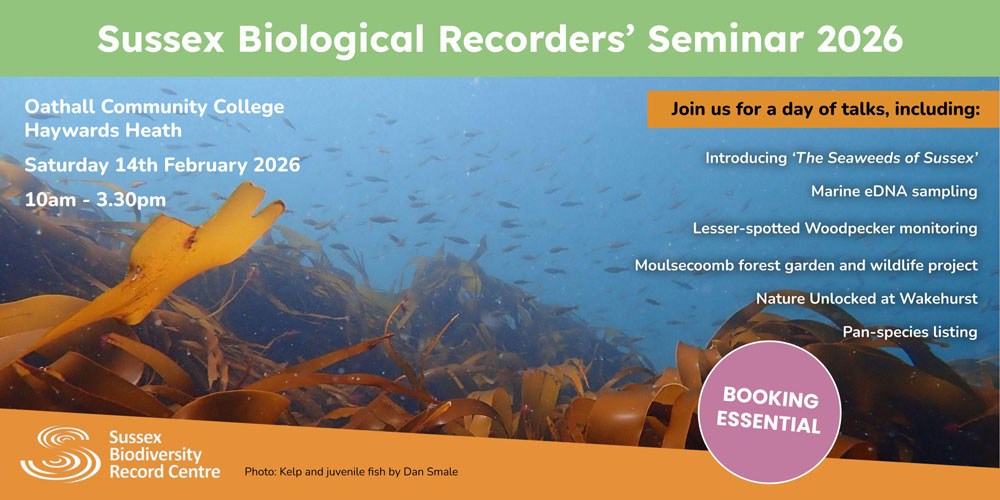
Date: Saturday, 14th February 2026
Time: 10:00am - 3:00pm
Venue: Oathall Community College, Appledore Gardens, Haywards Heath, RH16 2AQ
Join Sussex Biodiversity Record Centre on the 14th February 2026 for the 35th annual Sussex Biological Recorders’ Seminar, at our usual venue Oathall Community College. The Sussex Biological Recorders’ Seminar provides a unique opportunity to meet other people from Sussex’s wildlife recording groups, natural history societies and local conservation groups.
As well as talks, we also invite groups and recording schemes to bring a display and showcase their work around the hall, where you may find books and identification guides for sale. This is a great way to get involved with local community groups and network with other recording groups. There are also updates on atlas projects from Sussex recording groups and a short slot for anyone to advertise projects and initiatives to attendees before lunch.
This year’s talks will include:
Catering
Again we welcome back Seven Sisters Spices who will provide a delicious vegetarian buffet or you can bring your own lunch if you prefer. If you have any dietary requirements please make sure to let us know during the checkout process. Light refreshments will be available.
Display stands
You are welcome to bring a stand for your organisation or group. Please make sure this is booked during the checkout process.
Travelling to the venue
There is ample parking on-site. Oathall Community College is a 12 minute walk from Haywards Heath rail station. The nearest bus stop is Summerhill Lane. There is also a covered bike rack for bicycles.
Accessibility
There is level access to the hall and an accessible toilet in an adjacent building. If you have any specific accessibility needs or questions please get in touch. If you require a carer we are offering them free entry. Please just add a carer ticket to your order.
If you have any issues with your booking, or would like more information about the event, please contact sxbrc@sussexwt.org.uk or phone on 01273 497557
We hope to see you there!
13 October 2025
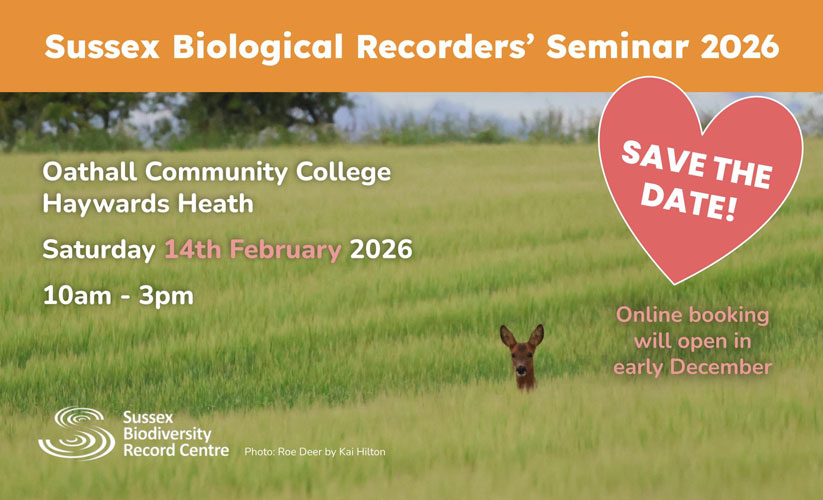
We are finalising the details for the 2026 Sussex Biological Recorders’ Seminar. Booking will open in December when we will be in touch again via our email newsletter with more details, so please save the date:
Saturday, 14th February 2026
10:00am - 3:00pm
Oathall Community College, Appledore Gardens, Haywards Heath, RH16 2AQ
We hope you'll join us!
17 December 2024
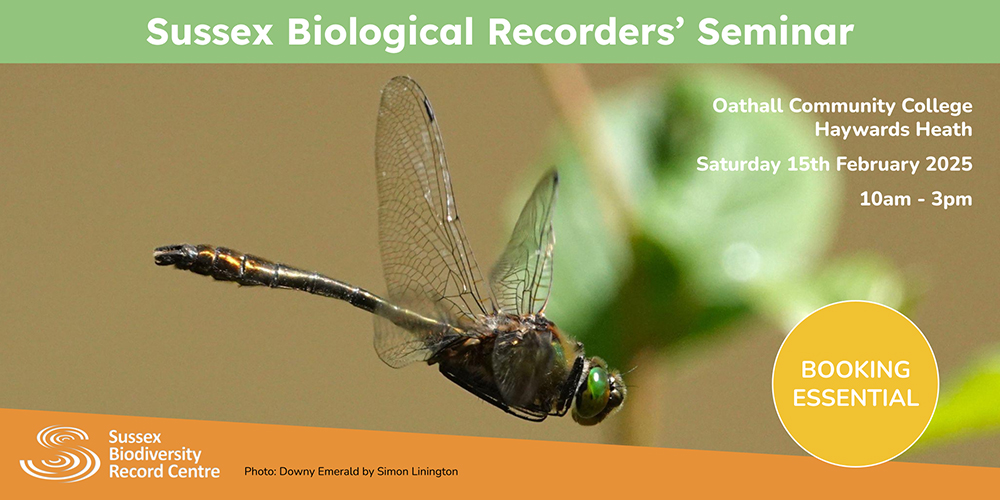
Date: Saturday, 15th February 2025
Time: 10:00am - 3:00pm
Venue: Oathall Community College, Appledore Gardens, Haywards Heath, RH16 2AQ
Join Sussex Biodiversity Record Centre on the 15th February 2025 for the 34th annual Sussex Biological Recorders’ Seminar, at our usual venue Oathall Community College. The Sussex Biological Recorders’ Seminar provides a unique opportunity to meet other people from Sussex’s wildlife recording groups, natural history societies and local conservation groups.
As well as talks, we also invite groups and recording schemes to bring a display and showcase their work around the hall, where you may find books and identification guides for sale. This is a great way to get involved with local community groups and network with other recording groups. There are also updates on atlas projects from Sussex recording groups and a short slot for anyone to advertise projects and initiatives to attendees after lunch.
This year’s talks will include:
Catering
This year we welcome back Seven Sisters Spices who will provide a delicious vegetarian buffet or you can bring your own lunch if you prefer. If you have any dietary requirements please make sure to let us know during the checkout process. Light refreshments will be available.
Display stands
You are welcome to bring a stand for your organisation or group. Please make sure this is booked during the checkout process.
Travelling to the venue
There is ample parking on-site. Oathall Community College is a 12 minute walk from Haywards Heath rail station. The nearest bus stop is Summerhill Lane. There is also a covered bike rack for bicycles.
Accessibility
There is level access to the hall and an accessible toilet in an adjacent building. If you have any specific accessibility needs or questions please get in touch. If you require a carer we are offering them free entry. Please just add a carer ticket to your order.
If you have any issues with your booking, or would like more information about the event, please contact sxbrc@sussexwt.org.uk or phone on 01273 497557
We hope to see you there!
22 July 2024

Ameira venthami sp. nov. (Line drawing © Yildiz & Karaytuğ 2024)
Sussex based marine biologist and taxonomist, David Ventham has recently had his work recognised by having a harpacticoid copepod named after him. Analysis of the morphology of specimens of Ameira parvula collected both off the Sussex coast and along the Aegean and Mediterranean coasts of Turkey by Nuran Özlem Yildiz, and Süphan Karaytuğ at Turkey’s Institute of Marine Sciences and Technology in Ïzmir and Mersin University has revealed a previously unrecognised species which the scientists have named Ameira venthami sp. nov. in David’s honour.
It remains to be seen whether any of the samples of unidentified Ameira spp. taken in Sussex waters by David 1993-1997 include A. venthami which he considers quite possible (indicating a possible distribution from Turkish waters through the Mediterranean to the English Channel). He gives an example of such a distribution for another species examined by his colleagues namely Ameira parvula nana (upgraded to specific rank A. nana) i.e. Cuckmere Haven, Sussex (first British record), Marseille to Turkey.
Downloads:
“Disentangling of an Ameira parvula (Claus, 1866) species complex with the description of a new species and remarks on the genus Ameira Boeck, 1865 (Copepoda: Harpacticoida: Ameiridae)“ (2.5MB )
“Harpacticoid copepods from the Sussex coast (eastern English Channel): records 1992-1997“ (1.3MB )
12 December 2023
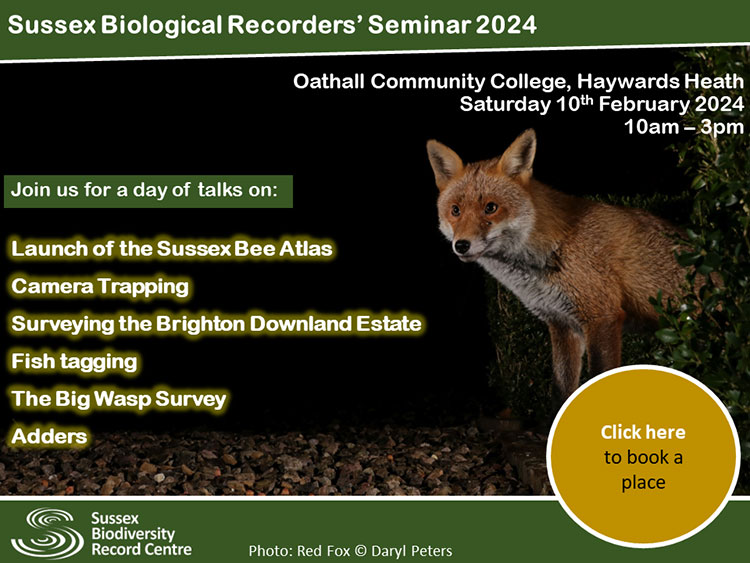
Date: Saturday 10th February 2024
Time: 10am – 3pm (Arrival from 9.30am)
Venue: Oathall Community College, Appledore Gardens, Lindfield, West Sussex, RH16 2AQ
Join Sussex Biodiversity Record Centre on the 10th February 2024 for the 33rd Annual Sussex Biological Recorders’ Seminar, at our usual venue Oathall Community College, Haywards Heath, from 10am to 3pm. The Sussex Biological Recorders’ Seminar provides a unique opportunity to meet other people from Sussex’s wildlife recording groups, natural history societies and local conservation groups.
This year we have a range of talks including Graeme Lyons on surveying the Brighton downland estate, and Dr Sam Kelly on engaging a community with adder conservation. Daryl Peters will share his experiences camera trapping in and around Worthing, and Sussex Wildlife Trust’s Living Seas Officer Sarah Ward on the FISH INTEL project to understand the movements of fish around the Sussex IFCA Nearshaw Trawling Bylaw area (and beyond!). We’re also delighted to have James Power launching his book ‘The Bees of Sussex’ ( don’t forget to pre-order your copy!), and Iona Cunningham-Eurich from the Big Wasp Survey talking about engaging citizen scientists with surveying an undervalued insect group.
This year we are thrilled to offer a vegetarian buffet lunch option from Seven Sisters Spices, or you can bring your own lunch if you prefer. If you have any dietary restrictions or preferences please list these in the ‘food options’ box, or email loismayhew@sussexwt.org.uk so we can make sure these are catered for. Light refreshments will be available.
You are also invited to bring a stand for your organisation or group, as there will be lots of opportunity to socialise and catch-up with fellow recorders. Please book this separately using this form: https://www.cognitoforms.com/SxBRC/DisplayStandBookingForm
Travelling to the venue: There is ample parking on-site. Oathall Community College is a 12 minute walk from Haywards Heath rail station. The nearest bus stop is Summerhill Lane. There is also a covered bike rack for bicycles. If you would like to carshare to the event, we have created an event page where you can add cars or look for car spaces near you here: https://carpoolorganiser.com/event/sussex-biological-recorders-seminar (Please note this service is provided by a third party site.)
Accessibility: There is level access to the hall and an accessible toilet in an adjacent building.
If you have any issues with your booking, or would like more information about the event, please contact sxbrc@sussexwt.org.uk or phone on 01273 497554
We hope to see you there!
11 January 2023
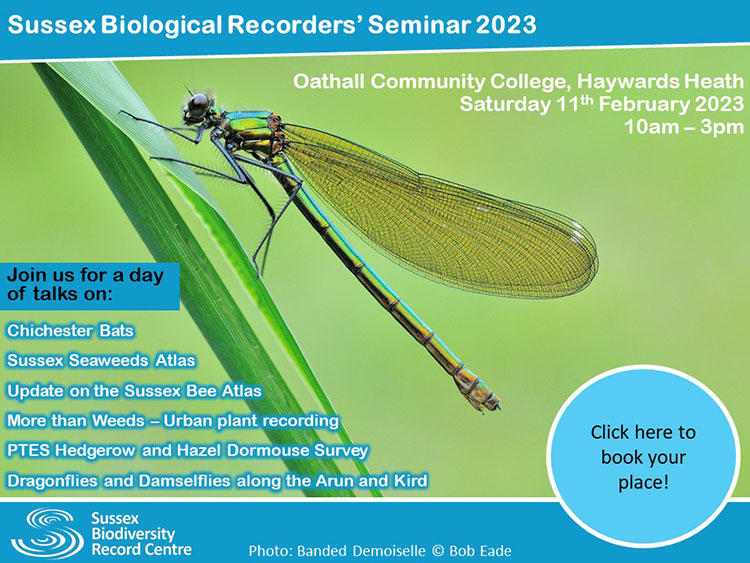
Date: Saturday 11 February 2023
Time: 10am - 3pm (Arrival from 9.30am)
Venue: Oathall Community College, Appledore Gardens, Lindfield, West Sussex, RH16 2AQ
Join Sussex Biodiversity Record Centre on the 11 February 2023 for the 32nd Annual Sussex Biological Recorders’ Seminar. This year we are returning to an in-person event, at our usual venue Oathall Community College, Haywards Heath, from 10am to 3pm. The Sussex Biological Recorders’ Seminar provides a unique opportunity to meet other people from Sussex’s wildlife recording groups, natural history societies and local conservation organisations.
We are delighted to have talks this year from James Power, updating us on progress towards a Sussex Bee Atlas, and Ian Tittley with a new atlas project: the Seaweeds of Sussex. This will be followed by an update on Kelp from Henri Brocklebank of Sussex Wildlife Trust. We will also be hearing about two Sussex-based projects: Linda Smith will talk to us about Chichester Natural History Society’s project using automatic bat detectors in North Chichester, and Alison Barker will be speaking about Dragonfly and Damselfly surveys along the rivers Arun and Kird. We are also delighted to be joined by the People’s Trust for Endangered Species who will be talking about the Great British Hedgerow Survey and Dormouse monitoring, and how you can get involved, and Sophie Leguil will be sharing her experience with the social media initiative ‘More than Weeds’ - promoting urban plant identification and recording.
There is a £5 charge for attending the seminar which includes tea and coffee.
There will be a second-hand natural history book stall, so please remember to bring some cash if you would like to make a few purchases to support SxBRC. Other organisations may also bring atlases and identification resources for sale. If you would like to bring a stand for your organisation or group, you are welcome to. We will contact anyone who has requested this option with more information prior to the event.
Please note that you will need to bring your own lunch, as there is no buffet lunch option this year.
Light refreshments will be available.
Travelling to the venue: There is ample parking on-site. Oathall Community College is a 12 minute walk from Haywards Heath rail station. The nearest bus stop is Summerhill Lane. There is also a covered bike rack for bicycles.
Accessibility: There is level access to the hall and an accessible toilet in an adjacent building.
If you have any issues with your booking, or would like more information about the event, please contact loismayhew@sussexwt.org.uk or phone on 01273 497554
1 December 2022
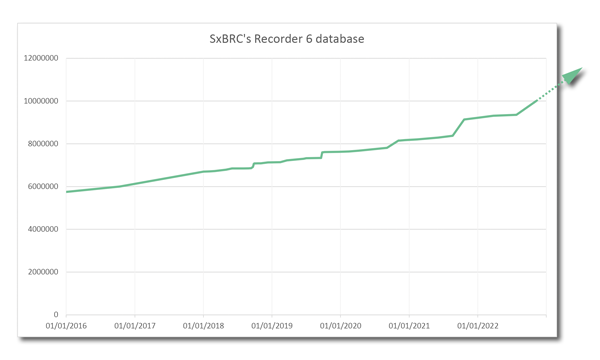
The steady increase in the number of records in the SxBRC database since 2016

SxBRC species record #10,000,000
Centrotus cornutus
It was an exciting day in the Sussex Biodiversity Record Centre on Monday 7 November. At approximately 11:30 a.m. we imported into the database the one hundredth record of the relatively uncommon Hemipteran Centrotus cornutus, a species of treehopper (family Membracidae) that can be found in various woodland habitats throughout spring and summer. Nice record. Always good to get an unusual bug record into the system.
Of the 22,951 taxa (taxa covers records of all ranks, e.g. species, genus, family etc.) that we have in the database, it is Sussex’s joint 3,658th most recorded, sharing that honour with such greats as Little Whirlpool Ram's-horn Snail Anisus (Disculifer) vorticulus, the leech Alboglossiphonia heteroclita and the beetle Tasgius ater.
But, by a funny (extraordinary?) coincidence, with that record being entered, it meant that, at that precise moment, EXACTLY 0.001%, one in every 100,000 of all the records in the SxBRC database, were of this species. The reason: this was also the ten millionth species record to be entered. However, things have moved on a little since that Monday, we’ve added another 100,000 or so records (it’s what we do…) and now Centrotus cornutus records form 0.00103% of all records in the database.
17 June 2022
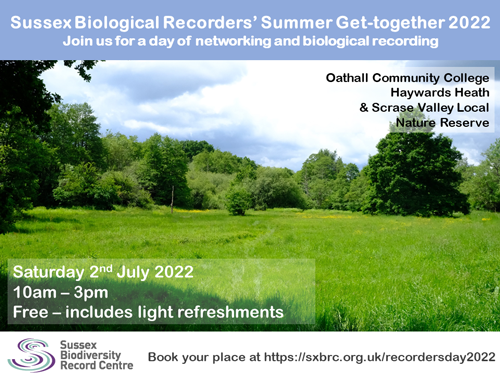
On Saturday 2nd July, Sussex Biodiversity Record Centre invites you to join on a day of networking, socialising and biological recording at Oathall Community College, Hayward Heath. You are invited to bring display boards for your group, or just come along and meet with your fellow Sussex recorders and SxBRC staff for refreshments and a chat, and then walk to nearby Scrase Valley Local Nature Reserve for an afternoon of recording.
This event is free. Please book a place through eventbrite, where there is the option to request a stall for your organisation.
Order of the day
10:00 - 12:30 Meet at Oathall Community College for refreshments and chat
12:30 - 13:00 Butterfly and plant walk with Bob Foreman and Dan Watkins
13:30 - 14:00 Nature Reserve walk with Becky Walton
12:30 - 15:00 Informal recording throughout the afternoon
15:00 - 15:30 Return and clear hall (the hall will be open and monitored all day for bag storage and bathroom use)
Please bring your own packed lunch.
If you have any questions about the day, please email loismayhew@sussexwt.org.uk
We hope you'll join us!
8 April 2022
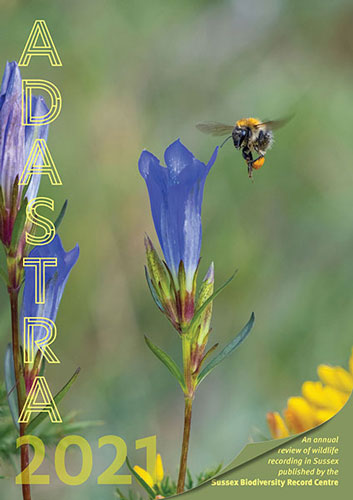
We are delighted to present Adastra 2021 - the annual publication written by the Sussex biological recording community and compiled by SxBRC.
In this year’s edition we have updates from local recording groups and county recorders for everything from mammals to beetles and bryophytes, and many (many!) more. There’s news on species new to Britain, local recording and atlas projects, and new Sussex recording initiatives which we hope will inspire you to get out and record, join in with a new group, or start your own project.
This year’s feature articles include a round-up of monitoring and recording on Sussex Wildlife Trust Reserves by ecologist Glenn Norris and reserve warden Chris Bentley, Simon Young’s recording project in the woodlands of Fairlight, and a write up by Evan Jones on the Pevensey Farmer’s recording day that took place in June 2021.
A heartfelt thank you to all our contributors who make this annual publication possible. We hope you enjoy reading it.
The SxBRC Team
17 December 2021
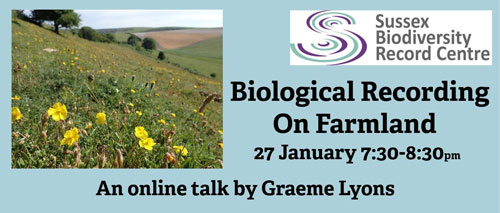
We were really hoping to hold a Sussex Biological Recorders’ Seminar as normal in February 2022, but we couldn’t find a way to make the event feel covid-safe and still provide the same experience to everyone, whether in-person or online. So we have made the decision that the February 2022 seminar will not be going ahead.
But don’t despair! Through the end of January to March we’ll be holding a series of Adastra-style online talks via Zoom that we hope you’ll join us for. We’re still ironing out the details, but forthcoming talks will include The Guermonprez Collection at Portsmouth Museum, an introduction to Craneflies, and DNA and Field Mycology. All talks will be free to attend.
Our first talk is by Graeme Lyons, independent ecologist and prolific pan-species recorder for Sussex (and beyond!), about his experiences carrying out farmland surveys and the incredible biodiversity that can be found there. Join us on Thursday 27th January at 7.30pm by signing up for the talk on Zoom, and stay tuned for a full schedule in January!
We’re hopeful that conditions this summer will allow us to hold an informal recording event and a catch-up, so please save the date Saturday 2nd July 2022 for a coffee (and cake) and some recording at Oathall Community College, Haywards Heath and the nearby Scrase Valley Local Nature Reserve. The event will be free to attend.
More details will be announced in 2022.
Finally, as with last year, we have made the Adastra publication available to pre-order online ahead of publication at the end of February 2022. You will be able to access a pdf version free of charge on our website, and copies will be available to pick up at the event in July, but if you’d like a paper copy posted to you it is available from the Sussex Wildlife Trust shop for a contribution of £4 towards the cost of printing and postage.
You can read previous editions, including the 2020 edition, on the publications section of the SxBRC website.
3 June 2021
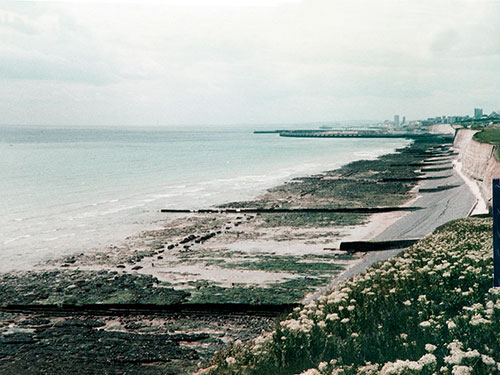
Ovingdean Gap covering the shore along Roedean to the marina east breakwater
Photo: D. Ventham
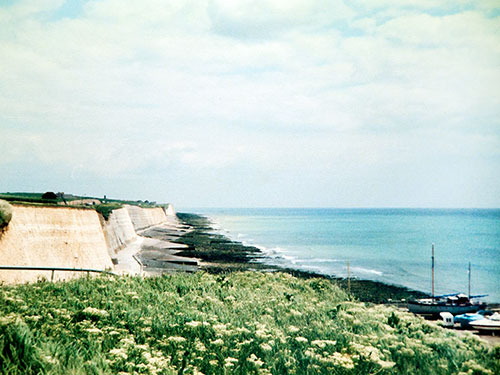
Roedean access slope with marina boatyard in foreground
Photo: D. Ventham
During lockdown, David Ventham set himself the project of updating the nomenclature of his comprehensive shore fauna monitoring project, which took place in 1981-1985 along the Roedean and Kemp Town coast, Brighton. The original reports were undertaken while David was working for the Nature Conservancy Council in 1990 and English Nature, south-east region, in 1992. The present work is a combination of the two, with classification and nomenclature updated to 2020.
The finished report, The shore fauna of Brighton, East Sussex (eastern English Channel): records 1981-1985 (updated classification and nomenclature) is now available to access via SxBRC’s publications page.
The harpacticoid copepod fauna of Sussex had not been investigated prior to this work, which then compelled David to undertake a 6-year project resulting in Harpacticoid copepods from the Sussex coast (eastern English Channel): records 1992-1997 published by the Booth Museum 2011 (available to download from our website) A large collection of Sussex harpacticoids, including first British records and species new to science, is deposited in the Natural History Museum, London.
Many thanks to David for getting in touch to share his work, if you have completed your own lockdown project, let us know!
28 May 2021
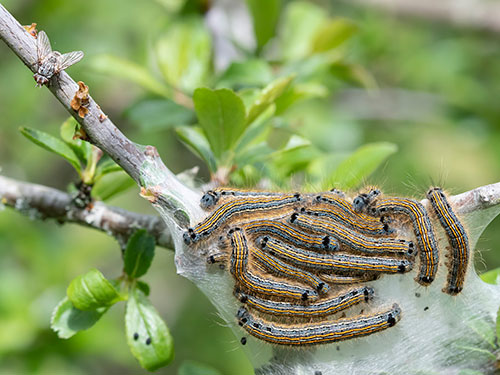
Goniocera versicolor watching Lackey larvae
Photo: Bob Eade
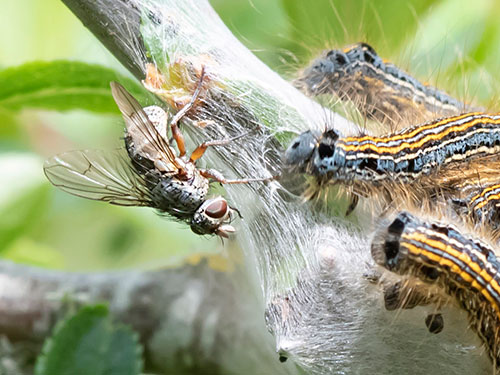
Goniocera versicolor close-up
Photo: Bob Eade
On a recent stroll on the South Downs above Seaford, Sussex based naturalist and wildlife photographer Bob Eade spotted a web made by the brightly coloured larvae of the Lackey moth Malacosoma neustria (a nice enough find in itself) having already found a larval web of the much scarcer Small Eggar Eriogaster lanestris. When he looked closer at the Lackey larvae Bob noticed a large fly showing a distinct interest in the larvae. As Bob says in his blog ( Bob’s Butterfly and Bird Blog), he was pretty sure that this was a parasitoid of the larvae because of not only the way the fly itself was behaving but also the way the larvae appeared agitated whenever it got close to them. Hoping that the photos that he took would be sufficient for an accurate identification he sent them to Colin Pratt, County Recorder for moths and Butterflies in Sussex asking him if he was aware of Lackey-specific parasitic flies. Colin passed the photos to Chris Raper, Manager of the UK Species Inventory at the Natural History Museum and organiser of the national Tachinid Recording Scheme. He confirmed the identy of the fly as Goniocera versicolor which until now, unrecorded in Sussex. Nationally this species is rare with a distribution focussed around Southwest England and Wales, this appears to be the most easterly record in the UK. The host species listed for this parasitoid are Lackey Malacosoma neustria, Ground Lackey M. castrensis (unrecorded in Sussex) and weirdly, Black-veined White Aporia crataegi.
If you spot larval webs, especially Lackey have a look for attendant flies and if possible get details and a photograph into iRecord.
7 January 2021
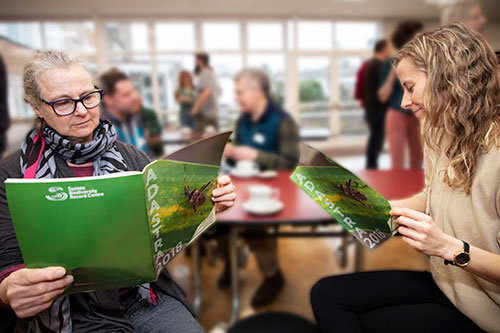
SxBRC made the decision last year that the annual Sussex Biological Recorders’ Seminar would not take place in February 2021. The nature of the event means that we don’t feel we could offer a suitable online or reduced capacity alternative, and we felt that if we couldn’t deliver the same kind of event then we would rather invest our time usually spent organising the seminar in other ways to connect the Sussex biological recording community. However, we are pleased to announce that the Sussex biological recording community’s annual review of recording in Sussex, will be available in February. As usual, the publication will be free to access online on the SxBRC website alongside all previous editions. For those of you that enjoy a printed copy, you can pre-order one to be posted to your door in February for £4 including p&p via the Sussex Wildlife Trust shop.
24 July 2020
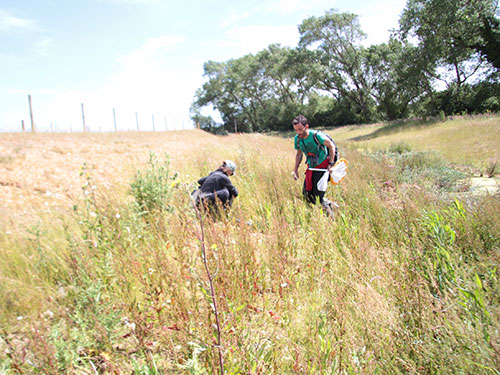
Laurie and Tom, mini-bioblitzing
at the EPIC Sompting site
Photo: Alistair Whitby
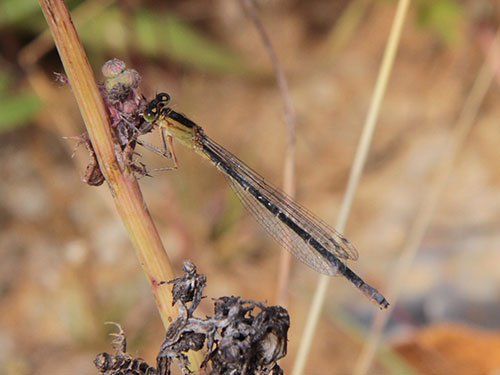
Female Scare Blue-tailed Damselfly
Photo: Alistair Whitby
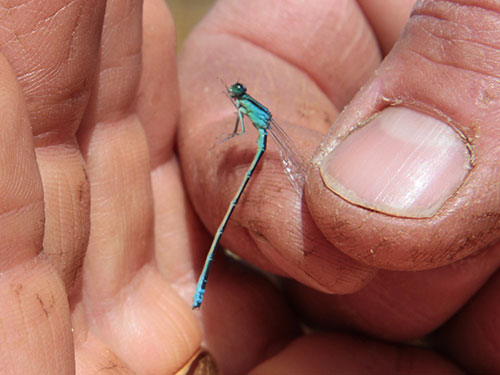
Male Scare Blue-tailed Damselfly
Photo: Alistair Whitby
A hot, sunny, breezy early afternoon on the banks of a stream restoration project in Sompting, was the scene of an exciting sweep netting incident on 19th June. Laurie Jackson and I had been invited to carry out a mini bioblitz at the EPIC Sompting site and working together with Alistair Whitby (OART project officer), socially-distanced of course, we were focussing on netting and ID’ing invertebrates along the newly formed and sparsely vegetated stream bank. Alistair netted a damselfly close to the warm shallow stream, which at first glance looked like Ischnura elegans, but lurking in the back of my mind was the need to double-check it and am I glad we did.
In the hand we examined the extent of blue on abdominal segments 8 and 9 and the pterostigma shape which seemed to be consistent with Scare Blue-tailed Damselfly (Ischnura pumilio) according to my British Dragonflies and Damselflies app (NatureGuides) and then frustratingly it escaped from the hand leaving us with only a couple of record shots and the feeling that this was a special find. There followed a weekend of running the photo by other experts online just to confirm the ID and consensus settled on pumilio - last recorded in Sussex 120 years ago!
The project, which has a strong volunteer focus, has been benefiting from regular Odonata survey visits by Dave Sadler, who was subsequently informed of this find. He then went to site (not currently accessible to public) to see if he could re-find the damselfly, which he did including several males and a female. One female has also since been found showing ageing consistent with ovipositing, so perhaps this is the start of an established Sussex colony. This species brought the site list up to 10 spp., which includes all the expected common Odonata and also Hairy Dragonfly.
To find out more about this project and follow developments please visit https://oart.org.uk/epic.
Tom Forward
3 July 2020
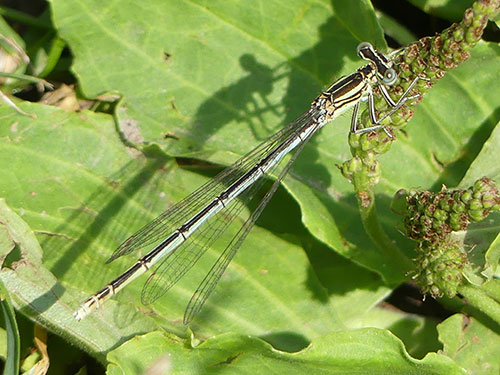
Female White-legged-Damselfly
Photo: Simon Linington
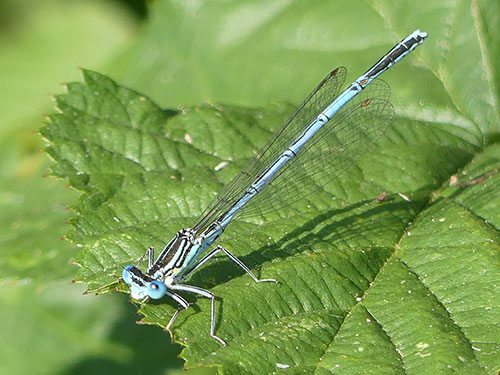
Male White-legged-Damselfly
Photo: Simon Linington
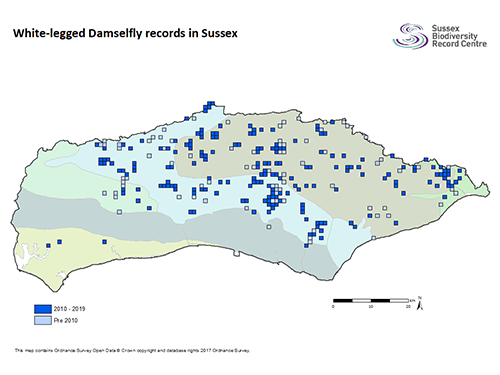
Distribution of White-legged Damselfly Platycnemis pennipes records in Sussex
Source: SxBRC
The British Dragonfly Society is asking for your sightings of White-legged Damselfly to help inform trends due to concerns of this species declining in the UK.
White-legged Damselflies are mainly found along slow-flowing lowland rivers and streams, and occasionally on canals or ponds. As the name suggests, they have obviously pale legs, males are a pale blue with black markings and females are cream with black markings. There is more information on how to identify them from similar blue damselflies on the British Dragonfly Society website (or there’s this pdf: https://british-dragonflies.org.uk/wp-content/uploads/2020/04/WLDI-ID-guide-2020-1.pdf)
The Dragonflies of Sussex (2004) noted that it is “predominantly found across the High and Low Weald, where it can be locally abundant, and well distributed along sections of the upper Arun and mid-Sussex Adur. There is an isolated presence at Chichester gravel pits.” Since then, there have been records from significantly more squares covering both the High and Low Weald and, notably, the far east of Sussex. This may well relate to consolidation and expansion of range but could possibly be explained by improved observer coverage.
If you see one, please submit records to iRecord with a photo if possible, or email it to bobforeman@sussexwt.org.uk
18 June 2020
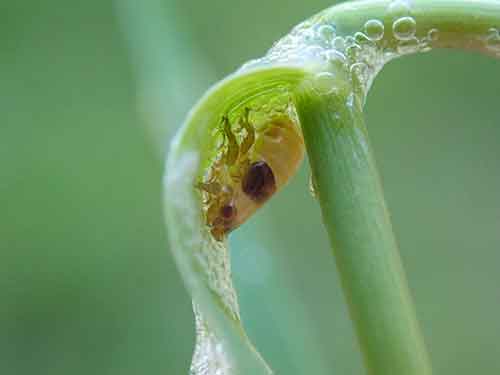
Neophilaenus lineatus nymph
Photo: Alan Stewart
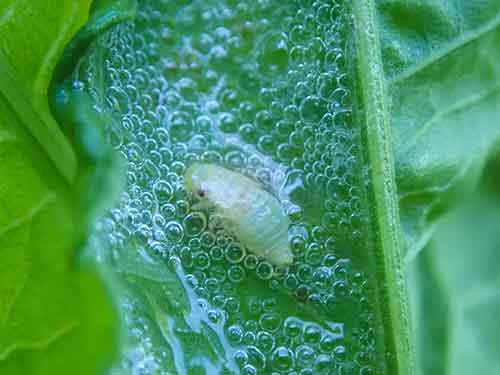
Philaenus spumarius nymph
Photo: Alan Stewart
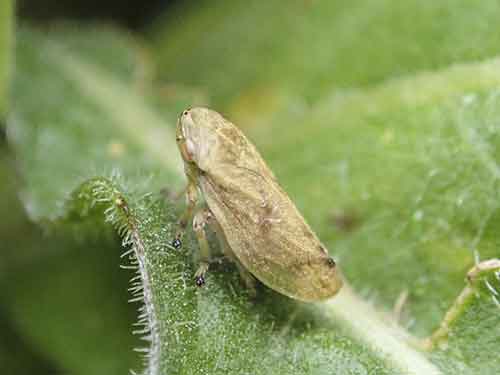
Adult Philaenus spumarius
Photo: Alan Stewart
Did you know that the ‘cuckoo-spit’ that you see in spring is produced by the immature stage (nymph) of a spittlebug or froghopper? It is thought that the spittle is produced to protect the nymphs from drying out and from their predators. Once the nymphs emerge as adults, usually in late June, they leave their spittle ‘nest’ behind and become free flying. The name froghopper reflects the fact that their face is rather bulbous and therefore froglike, and that they are one of the most powerful jumpers in the animal kingdom. There are ten species of froghopper in Britain. The so-called Meadow Spittlebug, Philaenus spumarius, is one of our commonest insects and has possibly the broadest diet of any insect, being known to feed on more than 400 species of plant.
Interest in these insects has recently been heightened by the fact that they all feed on the liquid contents of the plant xylem tissue and are therefore capable of transmitting various plant diseases that reside there. One of these, the bacterium Xylella fastidiosa, has recently been responsible for the death of millions of olive trees in southern Italy. Fortunately, the Xylella bacterium has NOT been found in the UK, but there is a danger that it could be accidentally introduced in imported plants (especially lavender, rosemary and olive trees).
We need to collect good data on two aspects of these insects to understand better how the Xylella bacterium would spread if it were ever introduced into Britain: the geographical distribution of the different species of spittlebug and what plant species they feed on. Last year, we started to collect some of this information through a national survey, funded by the Biotechnology & Biological Sciences Research Council (BBSRC) and coordinated through the RHS, focused on gardeners recording spittle on their garden plants. This year, the restrictions on movement due to Covid19 mean that we have to be careful about extending the survey into the wider countryside. Nevertheless, we hope that people will enjoy recording spittle in places that they visit as part of their daily exercise. Of course, those people lucky enough to have a garden will still be able to record the presence of cuckoo-spit on the plants in their garden.
Can you help? It would mean recording cuckoo-spit when you find it in your garden or elsewhere and especially the plant species on which you find it. Your plant identification skills will help us collect vital information. Please consider contributing to this important survey.
Much more information and an online form for submitting your sightings can be found on our website at:
www.spittlebugsurvey.co.uk.
We have developed an ‘exercise sheet’ for families to follow when confined to their gardens, that should appeal particularly to young children:
https://www.jic.ac.uk/app/uploads/2020/05/Spittlebug-activity-sheet-v2.pdf.
We have also recently released a short video on how to find spittlebugs:
https://www.youtube.com/watch?v=anfH8DAC7p8&feature=youtu.be
Please be sure to follow the government’s instructions at the time about social distancing when walking in the countryside.
Alan Stewart, University of Sussex
21 May 2020
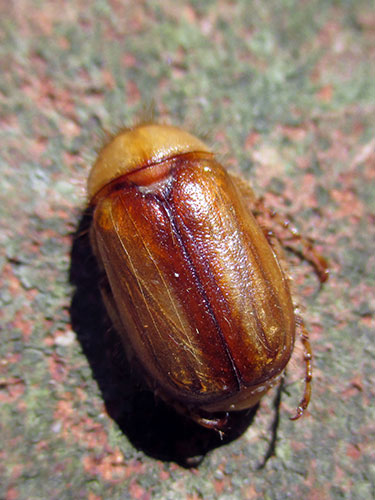
Rhizotrogus aestivus (Striped Summer Chafer),
Attracted to light on 25/04/2020 in Newhaven
Photo: Steven Teale
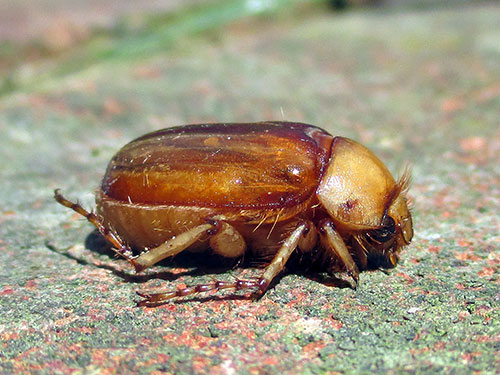
Rhizotrogus aestivus (Striped Summer Chafer),
Attracted to light on 25/04/2020 in Newhaven
Photo: Steven Teale
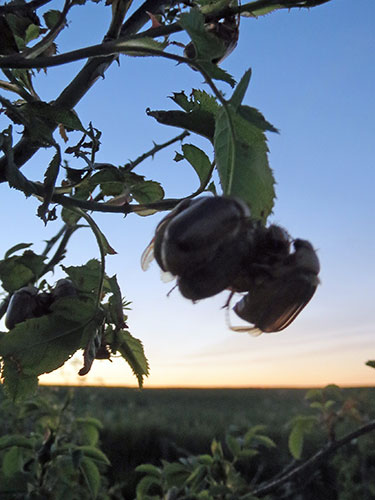
Rhizotrogus aestivus (Striped Summer Chafer),
A cluster of four males around a female, Poverty Bottom, 20/04/2020
Photo: Steven Teale
This month it has been confirmed that a beetle which was previously unknown in the UK outside of the Channel Islands is alive and thriving in Newhaven, East Sussex.
The beetle, Rhizotrogus aestivus, is a chafer similar in appearance to the familiar Summer Chafer (Amphimallon solstitialis), but smaller and less hairy. Like many other chafer species, it feeds as a larva on the roots of plants. Adults of the Striped Summer Chafer appear slightly earlier in the year than other closely related species, from April until June. As the name suggets, the wing-cases have a stripe running along them.
The adults appear shortly after sunset each night and are active for only about 25 minutes before settling down again. During this short time the males search for females, which perch low down on grass stems and appear to produce pheromones to attract the males. Although this chafer is much less clumsy than Cockchafers and Summer Chafers, it is still quite clumsy and can take some time to home in on a female. Clusters of several amorous males can be found clambering over a female and, where more than one female is in the same patch of ground, up to several dozen males have been found in a scrum around them.
The story of their discovery is rather unusual and slightly embarrassing. The first indivudual recorded in 2020 was attracted to a light trap I run each night in my Newhaven back garden. This is the embarrassing bit: I had been catching this chafer for at least two years, maybe even three or four, but passing it off as a Summer Chafer. It was only because the first one this year turned up on 20th April that I realised I had been wrong. It took several days of searching to find that it resembled Rhizotrogus aestivus. It was only when I checked the NBN Atlas and found no records of the species that I began to think it might be a special find. This was my email on 27th April to Bob Foreman at the SxBRC and Graeme Lyons:
“I’ve been recording Rhizotrogus aestivus in my moth trap for a few years, but have never bothered to record them. I saw today that there don’t appear to be any records on the NBN Atlas, so I thought I’d check whether this species of interest to you. If it is I’ll start recording it!”
After an initial flurry of excitement, Graeme forwarded my photos onto the national specialist for scarab beetles, Darren Mann. Darren was confident that the ID was correct, but needed to see the beetles up close. This was arranged and, on 12th May, Darren wrote:
“You’ll be pleased to hear that they are indeed Rhizotrogus aestivus (A.G. Olivier, 1789), I’ve given it a common name ‘striped summer chafer’ , by the numbers you’re seeing (as long as they’ve been confirmed by you) it can be given a status of ‘Established Introduction’.”
In the meantime I had checked back through my records and realised, to my shame, that I had not bothered to record when I’d found it in my trap in the past. The oldest record I could find was of one photographed at the end of April 2019 in Fort Road, Newhaven by my friend Sue Cross. This is the first sighting we can make a record from.
The discovery of this species is remarkable for a few reasons. Firstly, it is rare for such a large, conspicuous and charismatic beetle to have been overlooked until now. It is most likely that it hitched a lift, possibly on more than one occasion, on a boat across the English Channel rather than making the journey under its own steam, this being because of its bulk and poor command of the air. This is not uncommon; newly colonising species are often first recorded around ports such as Newhaven.
The astonishing thing about this previously unknown beetle is that we have found it in its thousands and in all places with well established grassland between Cliff Road in Peacehaven to the west and Poverty Bottom in the east. This area covers six tetrads. It could have colonised the area around Newhaven many years ago. Further searches will be made this year, so it might be even more widespread than we have already found.
It would be especially interesting if anyone else comes across this beetle while out just after sunset, or if it is attracted to a light trap. Please report this to Bob Foreman ( bobforeman@sussexwt.org.uk), along with a photograph, if you do.
Steven Teale
28 April 2020
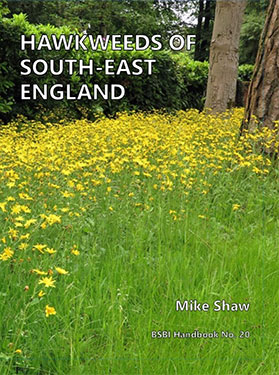
The latest in the series of BSBI Handbooks is coming soon! Hawkweeds of south-east England, BSBI Handbook No. 20, is due to be published in April 2020 but a special offer is open from now until 31st May. You don’t need to be a BSBI member to benefit from this special offer - it is available to everyone.
Hawkweeds (Hieracium spp.) are considered one of the trickiest groups of plants in Britain and Ireland, presenting a challenge to even the bravest botanist. BSBI Handbook No. 15 British Northern Hawkweeds by Rich & Scott brought identification of the northern members of this beautiful but difficult genus within reach and now Mike Shaw, Sussex-based hawkweed enthusiast, a BSBI member since 1988 and former BSBI County Recorder for West Sussex, hopes to do the same for the hawkweeds in his area.
In Hawkweeds of south-east England, Mike focuses on 58 species of hawkweed recorded in south-east England. He gives historical information, details of sites where you can see each of the species, notes on habitats and flowering times, a key to the eight hawkweed sections found in south-east England and identification tips to help you ID your hawkweed to species.
Hawkweeds of south-east England is a 250 page, A4 full colour hardback book illustrated with more than 400 colour photographs, distribution maps and herbarium specimens. The Handbook will retail at £35.00 but is offered until 31st May at the special price of £25.50 (excl. P&P). The quickest and easiest way to purchase your copy is to use the secure PayPal facility on the BSBI website. Read more about this new BSBI Handbook in the flyer which includes an order form for anybody who needs to pay by cheque.
If this book doesn’t completely satasify your thirst for hawkweed knowledge, we are very pleased to say that Mike will be writing a “species of the month“ feature on them that will coincide with their peak flowering later in the summer.
24 February 2020
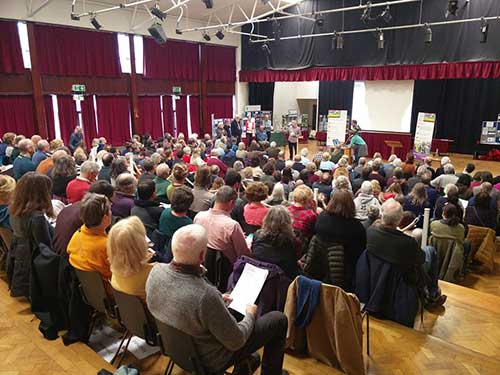
The crowd listen to another informative open mic slot after lunch
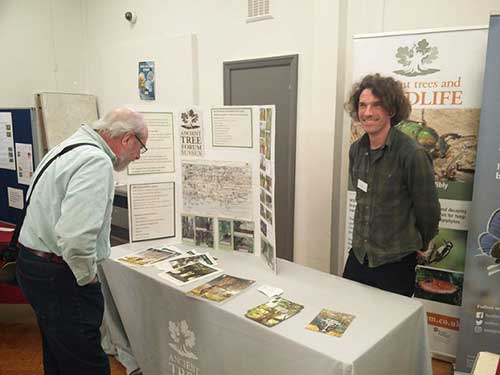
Sussex Ancient Tree Forum’s stand full of information on Sussex ancient trees
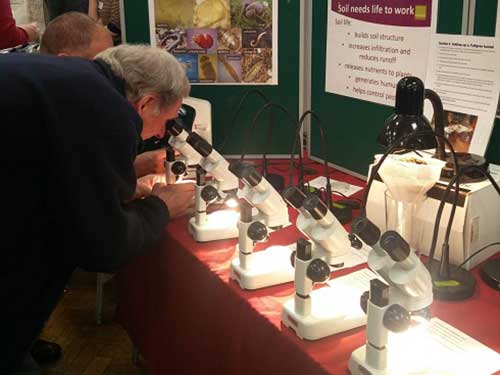
Dr. Matthew Shepherd brought along soil animals for everyone to view
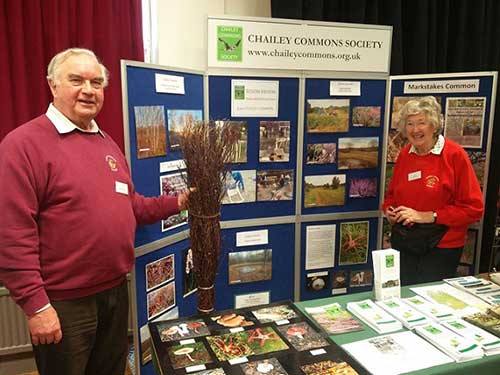
The Chailey Commons Society show off their broom!
The seminar opened with Sussex Wildlife Trust’s Michael Blencowe giving an introduction to the day and speakers, followed by SxBRC manager Clare Blencowe with the highlights from the 2019 Adastra publication - (which is now available to view online).
The first talk was from Dr. Matthew Shepherd of Natural England on soil biodiversity and invisible wildlife found in soils. Crowd favourites included space tardigrades, and mites with mites (with mites!). He then talked about the importance of soil conservation and how changing land use can affect the species found within soils.
Rachel Bicker and Susie Howells spoke next about recording at Moulsecoomb Forest Garden, a charity garden and outdoor education facility in Brighton. In 2018 the project started recording wildlife and running recording events on site, hosting events like moth mornings, bat walks and RSPB garden birdwatch for the local community. They are keen for other recorders and groups to go along to the site and help build the species list.
After the break John Walters talked about his voyage of discovery researching the Heath Potter Wasp, with beautiful illustrations and fascinating insights into the lives of these insects.
Chairman of The Conchological Society of Great Britain and Ireland and local Mollusc recorder, Dr. Martin Willing, then presented a journey through the creation of new coastal habitats at Medmerry, the UK’s largest sea defence scheme, and its developing molluscan interest with his predictions for future species we might find there.
After a vegetarian buffet lunch and a look round the informative stalls - including Matthew Shepherd’s microscopes to view soil mites and tardigrades, some lovely displays from local groups and Sussex projects - James Power gave us 10 notable Sussex bees and wasps in 10 minutes, with highlights including the Red-tailed Mason Bee which nests in empty snail shells, and the Five-banded Weevil Wasp which was recorded new to Sussex by James in 2019.
Dr. Barrie Watson followed on with news of the new Barn Owl Study Group, setting out the history of Barn Owl recording in Sussex and its challenges, and how to get involved in the project.
Helen Proctor from Sussex Botanical Recording Society talked about the impressive work of the Sussex Churchyard Survey over the last few years, with the challenges involved in surveying these sites (like tightly mown grass!) and some interesting findings on species richness in medieval churchyards vs Victorian, and how management is crucial to maintaining their biodiversity interest.
Phillip Briggs from the Bat Conservation Trust gave a talk on the National Bat Monitoring Scheme with a great overview of the bat diversity and recording effort in Sussex, and the different kinds of surveys to get involved in. There was also information on new developments in bat recording with audio devices such as the ‘AudioMoth’ which will provide robust trend information for bats in the UK.
Finally Graeme Lyons, County recorder for Spiders, gave a talk on his year ‘listing’ spiders, many of which hadn’t been recorded in Sussex in the last 50 years. He described how spiders are quite particular in terms of the structure and temperature of habitats they favour. Several Sussex nature reserves were found to be home to many notable spiders. Graeme also highlighted the British Arachnological Society as a great source of information about spiders and spider recording.
After some quick ‘thank yous’ to everyone involved in organising the day (when we forgot to mention our wonderful car-park volunteers, and our compère Michael - THANKS!) it was time for everyone to head out into the wind and rain of Storm Dennis and get themselves safely back home.
Thanks to everyone that attended for such an inspiring day. If you have any comments or ideas for next year please email loismayhew@sussexwt.org.uk and please keep in touch via the
SxBRC newsletter and Twitter for biological recording news updates.
We look forward to seeing you again next February!
10 December 2019
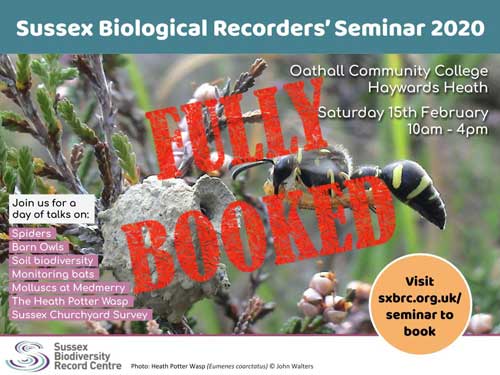
Booking for the 31st Sussex Biological Recorders’ Seminar is now closed.
Join us from 9:30 am on Saturday 15th February 2020 at Oathall Community College, Haywards Heath for a day of talks and chat.
We’ve got some great Sussex talks this year, from Martin Willing on monitoring the changing molluscan fauna of Medmerry, and Helen Proctor from Sussex Botanical Recording Society on their churchyard recording project. We’re also pleased to have entomologist and artist John Walters talking about the Heath Potter Wasp, a fascinating look at the world of soil biodiversity by Matthew Shepard, and Philip Briggs on the National Bat Monitoring Programme. Graeme Lyons will be sharing the joy of recording spiders (at the end, so any arachnophobes in the audience will have a chance to slip away quietly), and there will be some short talks on the newly formed Barn Owl study group by Barrie Watson and Rachel Bicker on a year of biological recording at Moulsecoomb Forest Garden.
There will be the usual stalls from local recording groups and societies and a plentiful supply of tea and biscuits! We’re asking for £4 to attend, and an optional £9.25 if you’d like the delicious vegetarian buffet provided by Veg Out catering.
Travelling to the venue: There is ample parking on-site. Oathall Community College is a 12 minute walk from Haywards Heath rail station. The nearest bus stop is Summerhill Lane. There is also a covered bike rack for bicycles.
Accessibility: There is level access to the hall and an accessible toilet in an adjacent building.
If you have any issues with your booking, or would like more information about the event, please contact loismayhew@sussexwt.org.uk or phone on 01273 497554
We hope to see you there!
The SxBRC Team
28 November 2019
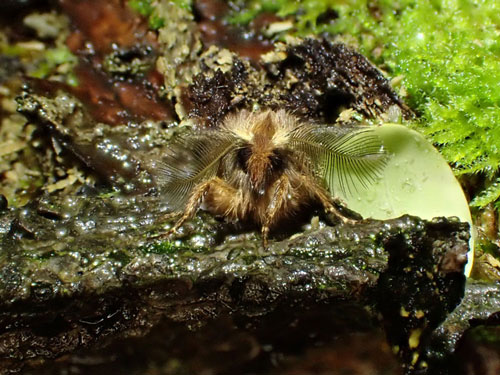
Male Plumed Prominent, Ptilophora plumigera showing how it gets its name
Photo: Dave Green
With above average rainfall across England, this autumn’s weather has really only been welcomed by mycologists, who it would appear are having a bumper season (although the southeast, and Sussex in particular, has been spared the worst of the rain according to the Met Office’s data with only a relatively small increase on the 1981-2010 average). The same cannot be said for the more entomologically focussed members of the recording community, especially lepidopterists, with many moth recorders reporting low numbers in their traps even when there has been a let-up in the weather. So it came as a welcome surprise when Dave Green, the author of this month’s “species of the month” feature on Plumed Prominent reported having successfully trapped 6 males on the West Sussex Downs on Monday (25 November). Despite numerous attempts this is only the seventh time this rare moth has been recorded in Sussex since 1990, showing that not only is this particular species very elusive but it’s worth being persistent when attempting to record species that have gone unnoticed for years. The full report of the find can be seen on the sightings page of the Sussex Moth Group website.
19 September 2019
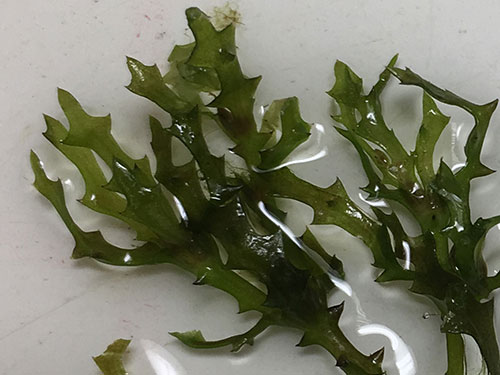
Holly-Leaved Naiad, Najas marina - close up of leaves and stem
Photo: Kathy Friend / EA
It is always exciting to receive reports of rare species being found in Sussex, especially when they are “county firsts”. Often, these reports are of vagrant flying insects that have accidentally wandered across from The Continent or of obscure, difficult to identify organisms that unless examined by an expert are easily overlooked. Far more unusual is a previously unrecorded plant, and not microscopic one either.
Kathy Friend, a biologist for the Environment Agency, informs us that on 18 September while monitoring for the invasive freshwater shrimp Dikerogammarus, a team from EA took samples from Darwell Reservoir which contained significant quantities of the rare aquatic plant Holly-Leaved Naiad, Najas marina. This is the first time that the species has been recorded in East Sussex and only the second time it has been found in all of Sussex. The only previous records are from the Arundel WWT reserve where it was found in 2015. Normally only found in mesotrophic waters in the Norfolk Broads, this plant is designated as WCA Schedule 8 and Vulnerable on the GB Red List, it has declined significantly in its range in the 1960s as a result of pollution but recent work has helped to reverse that decline.
This distinctive looking plant is to be found rooted in soft silty sediments in clear, undisturbed waters, usually at a depth of between 0.5 and 1.5 metres. As it has been found at Darwell it is well worth looking at other similar water bodies for the plant, and if you do find it please send the details along with photos to us at the SxBRC.
Sussex Botanical Recording Society’s Matthew Berry said, “One thing that does really fascinate me is the way it was discovered in this country by Arthur Bennett in 1883. Having made a comparative study of the Dutch flora and the flora of the “eastern counties”, he deduced that one of the Dutch species which should also be found in the Norfolk Broads was Najas marina, and soon afterwards found it at Hickling - one of the most satisfying examples of predictive field botany I know of!”
13 August 2019
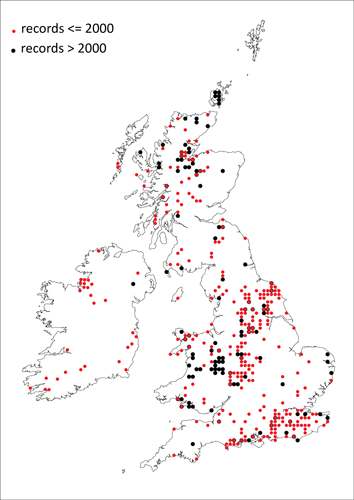
Dolichovespula norwegica used to be regularly found in the High Weald area, there are very few records after 2000
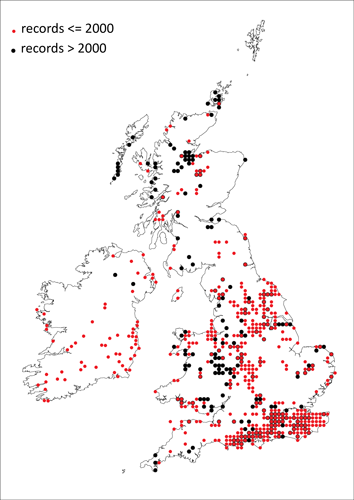
Vespula rufa was commonly found in many parts of Sussex, especially the heathy ones. Since 2000 it has become much scarcer
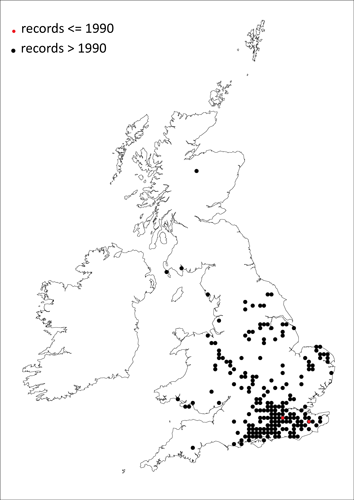
The early records for Dolichovespula saxonica in West Sussex were during the 1990s, soon after its first discovery in Surrey in 1989. Since then it has spread over much of Great Britain
There are nine species of social wasps currently established in Great Britain. We often just look at a wasp and think ‘jasper’ - however the different species react differently to environmental conditions and the distribution of individual species appears to be changing over time, with two species becoming much scarcer in the south-east - or are they? Do the maps show real changes in distribution, or just the lack of recording?
Your records can make a real difference to our understanding of these ‘common’ wasps.
Please send records and photographs or specimens (having some sort of voucher - be it a dead wasp (can be killed in a freezer) or suitable photograph improves the confidence in the data enormously, so be prepared to provide ‘the evidence’) or any queries to:
Mike Edwards,
Lea-side,
Carron Lane,
MIDHURST GU29 9LB
or ammophila@macace.net
Mike Edwards, BWARS
To help with identification of these social wasps Mike Edwards has produced an extremely helpful illustrated key with detailed photographs of the critical features needed for accurate identification.
This key can be downloaded here.
There’s much more information on social wasps on page 53 of the 2018 edition of Adastra and on the BWARS website.
11 July 2019

Norfolk Hawker showing distinctive green eyes and small yellow triangle on 2nd segment of abdomen
Photo: Christian Hance
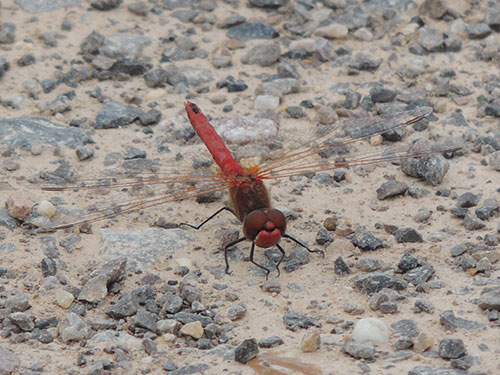
Red-veined Darter, an uncommon migrant species in Sussex
Photo: John Arnott
John Arnott from Chichester Natural History Society contacted us on Monday to let us know that on 5 July he had recorded a Norfolk Hawker, Anaciaeschna isoceles at Medmerry. He wrote the following:
“Norfolk Hawker at RSPB Medmerry this afternoon 05.07.19 at c. 13:35h at SZ8262896168. Bullying several Four-spotted Chasers. Took me a while to ID as it never stopped patrolling at warp speed. Process of elimination led to that ID and then it landed for 10 seconds, which nailed it. I was with Chichester Natural History Soc. conducting the annual dragonfly survey and Christian Hance (chair of the Society) got a good image of it landed. I went back at 14:00h having retrieved my camera from my wife and managed to get five photos of it in flight - blurred but good enough for validation. By then an Emperor had arrived so the Norfolk Hawker wasn’t king of the castle anymore as they both engaged in tail-chases, mostly the Emperor being dominant. Also a nice Red-veined Darter on the track at SZ8235995842.”
The record of the Red-veined Darter, Sympetrum fonscolombii would be a good one in its own right - we have had fewer than 50 Sussex records of this migrant species since 2000 (see our species of the month report on the darters) but this is the first time Norfolk Hawker, a red data book species and protected under the Wildlife and Countryside Act, has ever been recorded in Sussex. To add to the excitement, John contacted us a couple of days later to let us know that had received a report from Steve Webster, Site Manager at RSPB Pagham and Medmerry, of a mating pair of Norfolk Hawker having been been sighted at the same location.
We have had plenty of evidence of migrating insects recently so it’s well worth keeping a watch for these rare dragonflies at all wetland locations, especially the more coastal ones. Please report all your dragonfly sightings on iRecord, ideally with photographs of sufficient quality to show the identifying features in order to allow verification.
30 April 2019
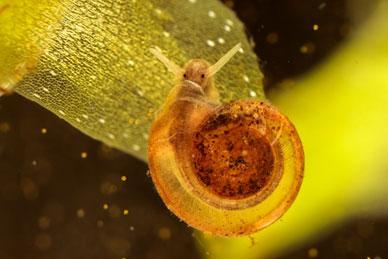
Anisus-vorticulus
Photo: Alex Hyde
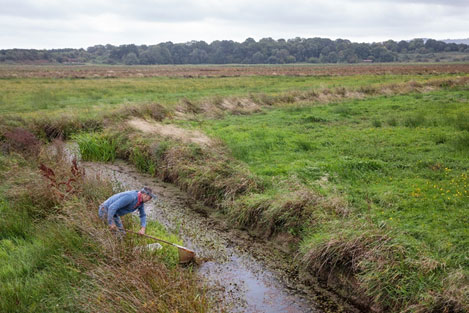
Toby Abrehart, sampling a ditch that’s had central channel clearance
Photo: Alex Hyde
Back from the Brink is an ambitious programme of work aiming to improve the conservation status of 20 of England’s most threatened species, whilst benefitting at least 200 more. With the support of the National Lottery Heritage Fund and other funders, 19 projects have been established across England, some covering particular geographic areas whilst others concentrate on individual species. Accounts of the projects, and information on how to get involved, can be found on the Back from the Brink website.
RSPB is leading a project on Anisus vorticulus, the Little Whirlpool Ramshorn Snail, at Pulborough Brooks reserve in the Arun Valley, from 2017-2021. The Arun valley is one of the three strongholds for the species in the UK, the others being the Norfolk Broads and the Pevensey Levels.
Anisus vorticulus is a small aquatic snail, rarely more than 5mm in diameter. It has very particular habitat requirements; it needs unpolluted, chalky waters such as marshland ditches, with just the right vegetation. It’s one of the rarest, most restricted and most vulnerable freshwater molluscs in Britain.
A survey carried out by Dr Martin Willing of the Conchological Society in 2013/14 found the population at Pulborough Brooks was expanding in the north of the reserve but was absent from the southern and central sections. A further survey of Amberley Brooks in 2015/16 found it was only present in 1 ditch. It is evident that the Arun population has greatly declined and is very vulnerable.
The cause of this decline is not clear. Past studies have suggested that the method of ditch clearance is the main problem, as the snail occupies well vegetated ditches and has not recolonised some ditches after clearance. The recommendation has been to leave stretches of ditch uncleared to act as a source for recolonisation. However, even when this management practice has been carried out for many years, it has not prevented the snail from being lost.
This form of ditch management can be problematic for land managers as the uncleared sections hamper water flow and lead to siltation, which is detrimental to much of the wildlife, including the snail. The ditches no longer function as wet fences, enabling livestock to move between compartments.
Through the Back from the Brink project we are testing four methods of ditch management in the hope that one can be found which both conserves the snail and facilitates the wetland management.
Anisus vorticulus is a European Protected Species and land managers are required to gain a licence to carry out ditch management. Under the terms of the licence they need to follow a ditch management protocol with the options of staggered clearance (whereby alternate sections are cleared and left uncleared); ends uncleared (for ditch lengths <100m) and half-width clearance (for ditches >4m wide). We have set up a replicated trial of each of these and in addition we are testing central channel clearance on the wider ditches.
2018 was the first year of monitoring of the ditch management trial, carried out under contract by Abrehart Ecology. Anisus vorticulus was found in all of the trial ditches and at most of the sampling points, larger numbers were recorded in the cleared parts of the ditch than in the uncleared. The monitoring will be repeated in 2019 and 2020 to see if this is a consistent finding.
In an attempt to improve the status of the snail, we have also created some additional suitable habitat in the form of 9 ditch spurs and 1 new ditch which can be allowed to vegetate up and do not have to act as wet fences or for water flow. These will be monitored in 2020 to see if they have been colonised.
If habitat conditions in the central and southern areas Pulborough Brooks were found to be suitable, we had planned to carry out some trial translocations in 2019. However, assessments in 2018 found many of the ditches had a very impoverished mollusc community, including several species more typical of ponds. Rather than carry out the translocations, we are now setting up water quality testing of the ditches to try to ascertain what the problem is.
The results of this project are being shared with Natural England and the Conchological Society, plus other conservation organisations and land managers with duty of care for Anisus vorticulus. In combination with studies in the Norfolk Broads, it is hoped they will inform future management for the snail. Anyone interested in learning more about this project should contact the project officer, Dr Jane Sears, at jane.sears@rspb.org.uk.


19 March 2019
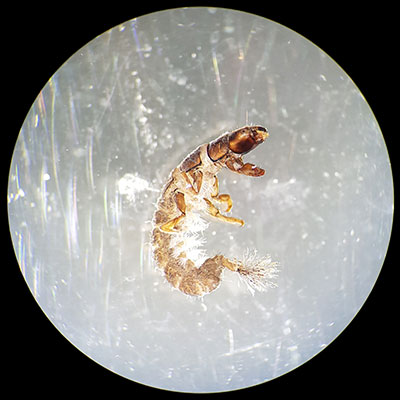
Hydropsyche saxonica larva
Photomicrograph: Alice Goodwin
A rare caddisfly, Hydropsyche saxonica (Hydropsychidae) has been found at two sites, not far apart in Sussex, in the headwaters of the Gatwick Stream. The Environment Agency (EA) were carrying out a survey to look at the possible environmental effects of a flood alleviation scheme. They came across the larval stage of the caddisfly in the samples of aquatic invertebrates. The EA knew that this was a caddis with a restricted distribution in the eastern part of the UK. They were delighted when Bob Foreman at the SxBRC let them know that these were the first confirmed records for the species in Sussex.
The larva of Hydropsyche saxonica look similar to Hydropsyche fulvipes and markings on the underside of the head and the shape of ventral chitinous plates (the pro-sternites and the submentum), are used to tell them apart.
In Central Europe both species are associated with headwaters, with saxonica generally extending further downstream than fulvipes (Pitsch 1993 cited by Edington & Hildrew 1995).
In common with other caddis families the larvae of the Hydropsychidae spin nets to trap food particles. For Hydropsychids these are usually in rapidly flowing water. In spring and summer these can be seen in abundance on moss covered stones.
Reference:
Edington, J.M. & Hildrew, A.G. 1993 Caseless Caddis Larvae of the British Isles. FBA.
Footnote:
More information on caddisflies and caddisfly recording can be found on the Trichoptera Recording Scheme website. Caddisflies are a particularly under-recorded species group with many of the records in the SxBRC database only having been identified to genus, family or even only "caddis sp.". We would therefore really appreciate new, good quality records of these insects.
21 February 2019
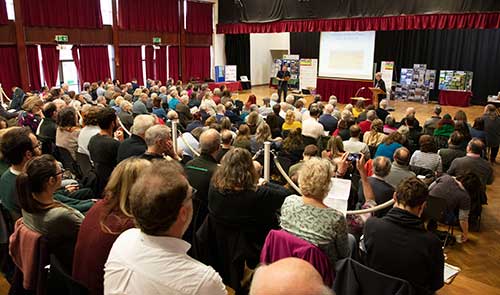
It was a full crowd on the day, with over 250 people in attendance
Photo: © Graham Franks / Sussex Biodiversity Record Centre
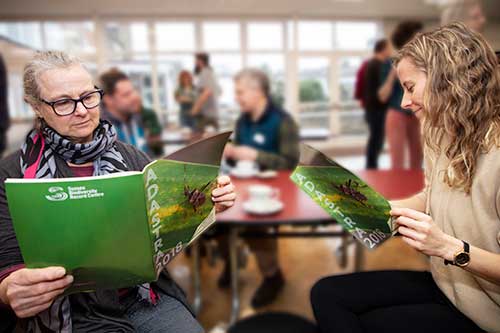
Immersed in Adastra
Photo: © Graham Franks / Sussex Biodiversity Record Centre
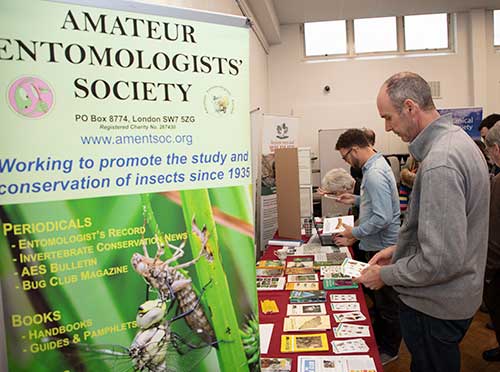
The A.E.S. stand being examined during one of the breaks
Photo: © Graham Franks / Sussex Biodiversity Record Centre
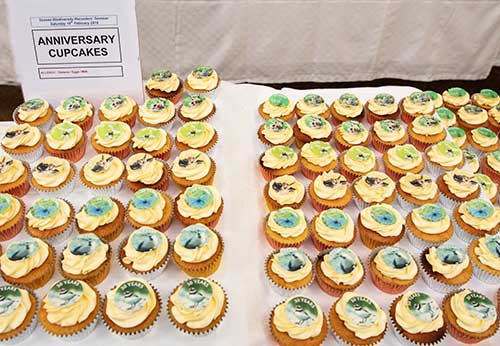
A small selection of the hundreds of Anniversary Cupcakes that were consumed on the day
Photo: © Graham Franks / Sussex Biodiversity Record Centre
The day began with an introduction from Sussex Wildlife Trust’s Michael Blencowe, filling in for Clare who was suffering from a minor dose of food poisoning and not quite up to the challenge of MC-ing the day. Clare gave just a very brief introduction to the contents of the 2018 ‘Adastra’ publication: the annual review of wildlife recording in Sussex, published by Sussex Biodiversity Record Centre. This year the publication has gone FULL COLOUR and Clare showcased a few highlights, including an article by Robin Crane on the origins of the Biological Recorders’ Seminar - 30 years old this year!
Tony Whitbread was the first to speak, giving an insight into the early days of the Biological Recorders’ Seminar back in 1990 and how, despite many mistakes in the beginning, the success of the seminar grew and grew to become the event we know now. Tony highlighted the importance of sharing our community’s knowledge and experience of Sussex wildlife, and using this to help preserve species for future generations.
John Arnott, a volunteer with Chichester Harbour Conservancy, followed with a talk on the seals of Chichester Harbour. John explained how to identify seals and neatly summarised the research and monitoring that’s been taking place, showing how seals use the harbours at Chichester & Langstone, and the Solent.
After a coffee break (with anniversary cupcakes!) and some time to look round the various stands, we were back with Martin Allison’s fascinating talk on the fungi of Lullington Heath including fairy rings, waxcaps and things that grow on sheep dung. Steph Miles and Jenny Peach from Royal Botanic Garden Kew Millennium Seed Bank then introduced us to three major projects - UK Flora Project, UK National Seed Project and the UK Native Seed Hub. It was great to hear how RBG Kew are supporting various conservation projects in Sussex.
Over lunch, the hall filled with chatter, as people enjoyed the buffet lunch and refreshments provided by Diane and Harry’s team from Veg Out catering.
Brad Scott then gave a talk about Bryophyte recording from 1721 - 2018, featuring the first known Sussex bryophyte record - Riccia fluitans - recorded by Johann Jacob Dillenius, and a short history of Sussex-based bryologists. The Sussex atlas project was initiated by Tom Ottley, with the aim to get 100 records per 1km square across Sussex. Good progress has been made across East Sussex where most society members live; progress in West Sussex is slower but there’s considerable improvement and the species list for Sussex is ever growing.
Fran Southgate was delighted to share the news that otters are ‘Here at Last’ in Sussex. Her talk featured some lovely video footage of adult otters with young, showing us that they are now breeding in some areas of Sussex after a long absence. Fran went on to explain how to identify signs of otter, and how these differ from commonly confused species such as American Mink. Any possible otter sightings should be sent to bobforeman@sussexwt.org.uk for verification.
Daniel Watkins from the Sussex Local Wildlife Sites Initiative talked about his progress since starting as the Local Wildlife Sites Officer last June, with Henri Brocklebank of Sussex Wildlife Trust describing the process of forming the initiative and how important the biological recording community and Sussex’s network of nature organisations are to the preservation of these sites.
After a final tea break, Björn Beckmann talked gave us an overview of the National Grasshopper Recording Scheme and how data collection works through iRecord. Ralph Hobbs, iRecord verifier for Sussex Orthoptera records, provided some additional local context. Björn then gave an insight into the uses of this data in his PhD, and the challenges of working with casual recording datasets.
Finally, Emma Sherlock, curator at the Natural History Museum and chair of the Earthworm Society of Britain, gave an introduction to the world of earthworms and the challenges of setting up a new recording scheme. Emma’s brimming enthusiasm for these often over-looked creatures will hopefully inspire some folks to start recording earthworms in Sussex.
After a final list of ‘thank yous’ to all the speakers, organisers, caterers and attendees, it was all over for another year! The date for the next seminar will be announced through the SxBRC newsletter and social media channels in the summer, and we hope you can all join us next February!
12 December 2018
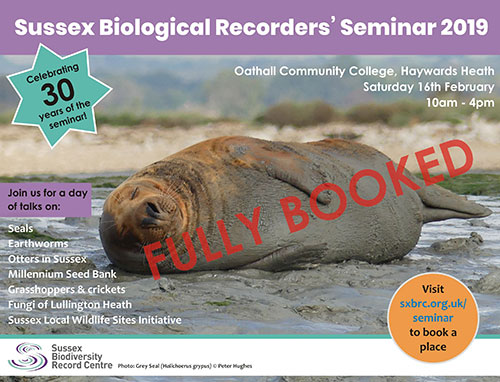
Join us from 9:30 am on Saturday 16th February 2019 at Oathall Community College, Haywards Heath for a day of talks and chat.
We’ve got some great speakers lined up this year: Steph Miles and Jenny Peach from Royal Botanical Gardens Kew will be talking about UK seed conservation, and Bjorn Beckmann, from the Biological Records Centre at CEH, along with local entomologist Ralph Hobbs, will be telling us all about grasshopper recording in Sussex and across the UK.
We’ll also have local mycologist Martin Allison speaking about the fungi of Lullington Heath; Brad Scott and Sue Rubinstein, from the South East Group of the British Bryological Society, on the Sussex bryophyte atlas; Fran Southgate from Sussex Wildlife Trust with an update on Sussex Otters; and John Arnott, a volunteer with Chichester Harbour Conservancy, talking about the Seals of Chichester Harbour - the only breeding population of Common Seals in the eastern side of the English Channel.
Emma Sherlock from The Earthworm Society of Great Britain is coming to give an insight into recording earthworms in the UK, and Henri Brocklebank, from Sussex Wildlife Trust, and Dan Watkins, from the Sussex Local Wildlife Sites Initiative, will be giving us an update on a new partnership project focusing on Sussex Local Wildlife Sites.
We’re very pleased that Tony Whitbread, organiser of the first ever seminar in 1990, will also be joining us and sharing his thoughts on 30 years of the Sussex Biological Recorders’ Seminar and the impact that biological recording has had on nature conservation in our county.
There will be the usual stalls from local recording groups and societies and a plentiful supply of tea and biscuits! We’re asking for £4 to attend, and an optional £8.95 if you’d like the delicious vegetarian buffet provided by Veg Out catering.
You can book your tickets online - please email loismayhew@sussexwt.org.uk if you have any questions.
We hope to see you there!
27 November 2018
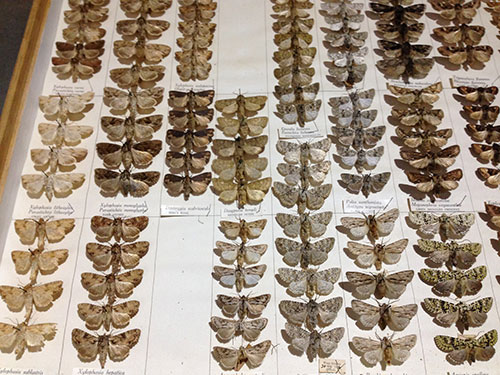
A drawer of Noctuid moths from the Guermonprez collection
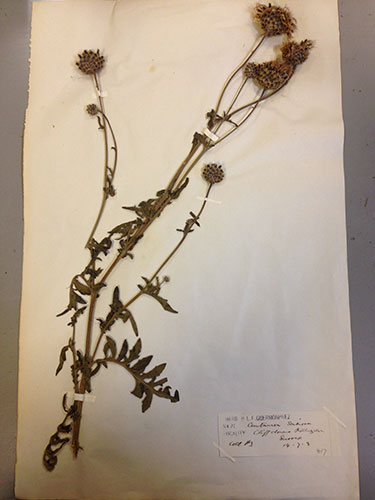
A specimen of Centaurea scabiosa from the HLF Guermonprez Herbarium
In March 2018 Portsmouth City Council was awarded a £79,700 grant to deliver the ‘Wild about Portsmouth’ project, aimed at raising the profile of the city’s Natural History Collection, which had been without a curator for over 10 years.
The project has enabled the development of natural history advocates and a team of volunteers to work on and promote the collection, as well as engaging with people in a variety of ways, from family activities to specialist workshops.
Since May 2018, work has been made to gain an overview of the collections, appoint volunteers and an assistant (starting in January 2019) and sharing newly found collections knowledge with local and national societies.
The largest and most important collection is that amassed by HLF Guermonprez (1858-1924) who lived in Bognor Regis between 1892 - 1924. This collection was transferred to Portsmouth Museums in the 1970s where it is held in Trust.
HLF Guermonprez was an avid collector, and the scope of his collection certainly reflects his enthusiasm for Natural History. He confined most of this collecting to Bognor Regis and the counties of West and East Sussex, recording where and when he found each specimen. Although some of his work is mentioned in publications such as the Flora of Sussex (1937) and the occasional entomological journal, many of Guermonprez’s collections remain under recorded.
Sussex biological specimens held in Portsmouth’s Museums
Plants
There are about 9,000 plants collected by Guermonprez in the herbarium. To date 3142 have been identified as collected from Sussex. Other collections with Sussex specimens include the A W Westrup Herbarium, which contains 153 sheets of plants from Sussex, and the John Jenkins Herbarium.
Entomology Collection
The majority of the collection are Lepidoptera and mainly from the Guermonprez Collection. Work has started on cataloguing the moth collection and a first analysis of the 561 records forwarded to Bob Foreman has shown ‘new spots on the map’. It is hoped that once the new ‘Insect Room’ is up and running, the moths and their data can be checked and added to the moth records for Sussex.
Taxidermy
There are about 800 taxidermy specimens in the Guermonprez Collection. Of these 116 are birds listed as being from Sussex over a date range of 1851 - 1925. The specimens from the mid-19th century, although part of the Guermonprez Collection, were previously in the Knight Collection. There are also a few small mammals collected in West Sussex.
Access to the Collections
At present the herbarium is the easiest collection to access and volunteers have been the key to organising the collection into taxonomic order. The insect collections are currently awaiting relocation so that they can be accessed more easily. They will be moved to their new location by the end of January 2019 and, once in place, it is hoped to appoint entomology volunteers to work through the insect collections and catalogue them.
By the end of the project in 2020 it is anticipated that the collections will be more readily available for consultation. Cataloguing projects will be driven by data requests and national recording schemes so that data can be shared more efficiently.
To arrange a visit to view the collections please contact the Curator of Natural History, Christine Taylor by email Christine.taylor@portsmouthcc.gov.uk
Christine Taylor
Curator of Natural History, Portsmouth Museums

5 October 2018
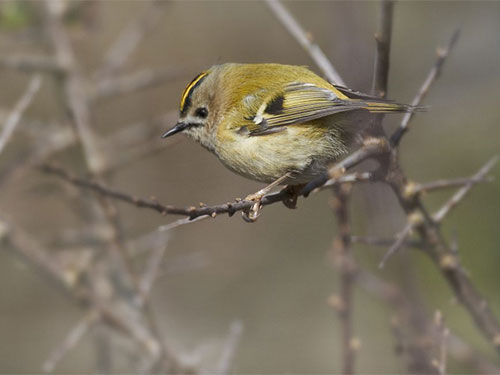
Probably not this actual one but possibly a friend or relative of record #7,000,000
Photo: ALAN PRICE, GATEHOUSE STUDIO/Sussex Wildlife Trust
The time has come for the SxBRC to a bit more honking of its own horn. On 25 September at 10:01am the number of species observations in the SxBRC’s database reached the 7,000,000 mark. This was thanks in no small part to the Sussex Ornithological Society which had, a few days earlier, sent us with the annual “bird migration” and it was during the import process of these quarter million records that the 7,000,000 threshold was crossed. The actual record, the one that became the seven millionth, was of a Goldcrest that was seen in the Pannel Valley Nature Reserve in the far east of East Sussex at Icklesham on 6 January 2017. Of course, it is purely coincidence that this record should be a bird, it could quite easily have been any one of the 21,821 different species from the 1,712 families for which we have records in the database. For every square kilometre of Sussex we hold, on average, more than 1,840 records and it is the entire Sussex biological recording community that we have to thank for these records which allow us to report so comprehensively and thoroughly about the wildlife that occurs in any part of Sussex.
27 September 2018
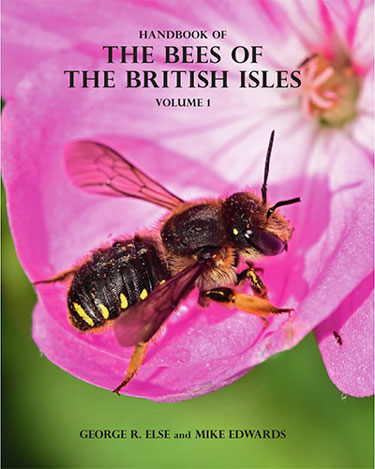
The cover of Handbook of the Bees of the British Isles by George Else and Mike Edwards
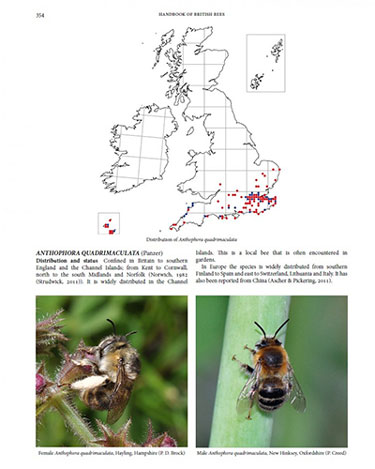
Sample page from Handbook of the Bees of the British Isles
The 2-volume Handbook of the Bees of the British Isles represents the culmination of over 40 years' study of the British bee fauna by authors George Else and Mike Edwards. They have drawn heavily on their experience in their home counties of Hampshire and Sussex, both counties with a large proportion of the British bee fauna, as well as undertaking targeted investigations throughout the region. They have also used a wide range of published and personal observations. The volumes have been printed to a high standard on good quality paper, with a clear and uncluttered layout developed in association with printers Henry Ling of Dorchester. A notable inclusion in the price is a DVD providing large-scale copies of all the key illustrations.
The Handbook of the Bees of the British Isles may be purchased from the Natural History Bookshop.
4 September 2018
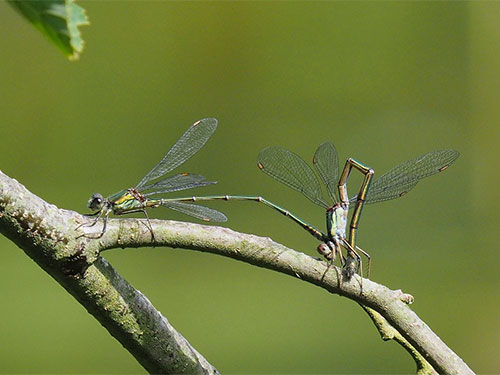
Willow Emeralds ‘in-cop’ showing characteristic pale brown pterostigma. Like other emerald damselflies, this species rests with its wings apart.
Photo: Dave Sadler
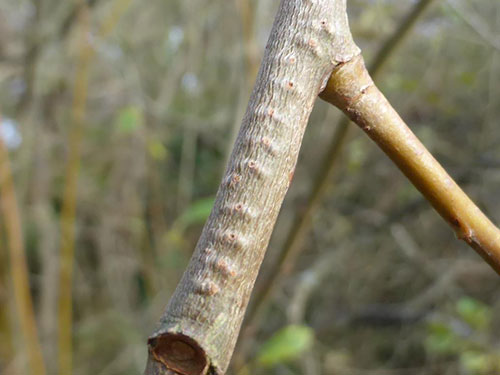
The distinctive scars in willow bark left by ovipositing Willow Emerald
Photo: Michael Blencowe
According to the British Dragonfly Society’s website the Willow Emerald Damselfly (Chalcolestes viridis) is a recent Continental colonist in the UK with the first significant number of records coming from Suffolk in 2009 and 2010 with more being seen in Norfolk, Essex and Kent.
The first Sussex record is of a dead specimen found near Pevensey in 1979, the species was reported again at Warnham Nature Reserve in 2004 but after that, wasn’t seen until 2016 when Dave Sadler spotted two males here at Woods Mill in September 2016. In 2017 the species was seen on numerous occasions at Woods Mill and again too at Warnham. At Woods Mill females were observed ovipositing on the branches of willows overhanging the pond, leaving their distinctive “scars” in the bark.
However, not only have Willow Emeralds been seen again at Woods Mill this year, reports have come to us of sightings in East Sussex, at Winchelsea and Broadwater Warren, the first records of living individuals from East Sussex. It appears that this species is not only becoming established in Sussex it is also spreading. The flight season is just getting underway and we would be very keen to get more records, so if you do see one of these distinctive damselflies, please either enter your records on the iRecord website or send them directly to Bob Foreman at the SxBRC.
27 July 2018
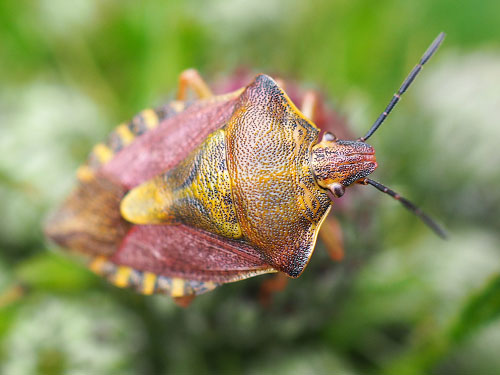
Black-shouldered Shieldbug (Carpocoris purpureipennis), first recorded in Sussex in 2017.
Photo: Derek Binns
Shieldbugs are the most popular and well recorded group of the Heteroptera. They are large, readily identifiable in the field and evident throughout the summer months. With only around 50 species if you include the squash bugs, they are not too tricky to identify and online resources such as British Bugs are a real help. A few years ago Graeme Lyons, the Sussex County Recorder for Heteroptera, started to talk to the SxBRC about producing an atlas of shieldbugs but rather than go for a book, we thought an online resource would be more suited, that way it can evolve as the Sussex shieldbug recording community also grows. The Sussex Biodiversity Record Centre with the help of Mark Robey (a freelance GIS specialist) put the atlas together with Graeme providing the text and most of the imagery. It covers all the Sussex shieldbugs, squash bugs, rhopalids and a few more families in there as a bonus.
The Atlas of Sussex Shieldbugs allows you to click on the 10, 2 or 1 km square you are recording in and see what species, if any, have been recorded there and how many records have been made of them. It also allows you to click on individual species and read a bit about them including their identification including a photo, how to find them and their status in the country and in Sussex. These distribution maps will grow with time as more records are made and a more complete picture of our counties’ fauna is made.
Click here to view the Atlas.
iRecord is the best way to record your Shieldbug sightings (Graeme is County Verifier) and your records will not only quickly get to the SxBRC they will also be entered into the data in the Atlas
18 May 2018
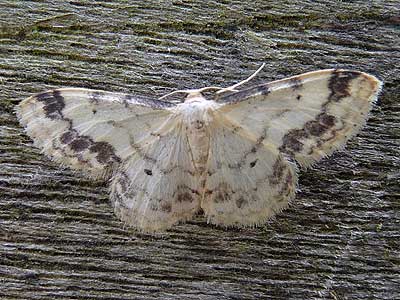
Treble Brown Spot - not the Pagham one but our millionth moth...
Of the 6,834,363 (at time of writing) records we have in the database, 3,008,242* of those are of birds, 1,075,751 are of flowering plants and, as of today, there is now a third taxonomic group with more than one million Sussex records - moths! Over the past few weeks we have collated and imported approximately 80,000 new records (the vast majority of which were collected in 2017) and thanks to the avid moth recording community in Sussex, the total now stands at 1,000,873. Every one of these records has also been passed through the rigorous scrutiny of our dedicated County Recorder for Lepidoptera, Colin Pratt.
I had hoped that record #1,000,000 would be of some spectacular or particularly scarce species but having checked the import logs it would appear that record #1,000,000 is of a Treble Brown Spot Idaea trigeminata - not particularly scarce or spectacular but undoubtedly an attractive little moth - It was recorded at Pagham Harbour last June.
*Sorry, birds - I’m a bit moth obsessed and didn’t notice you passing the 3 million records milestone.
10 April 2018
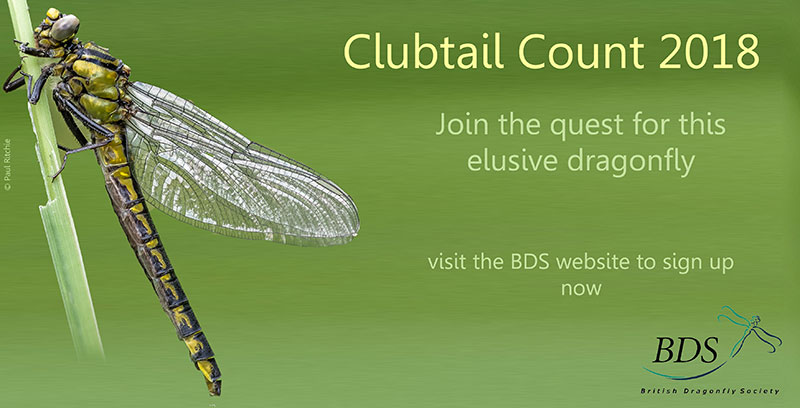
Join the quest for this elusive dragonfly.
The Common Clubtail Dragonfly is a near threatened species restricted to a handful of unpolluted, slow flowing rivers in England and Wales. We desperately need to understand the population size and distribution of this dragonfly to conserve it, but records for this elusive species are patchy and dated.
We intend to change that.
We are calling on all nature lovers to join us in the search for this beautiful insect. No previous experience in dragonfly identification is needed, we will teach you all you need to know to find this local specialist.
You can give as much or as little time as you like, with all efforts making a valuable contribution to the conservation of a symbolic riverine dragonfly.
It is fun and simple: take action now!
If you live near the Sussex Arun visit our website to book your survey square now!
If you have any questions, get in touch with our Conservation Officer, Genevieve Dalley.
Visit www.british-dragonflies.org.uk/content/clubtail-count
Download the BDS Clubtail Count 2018 poster here
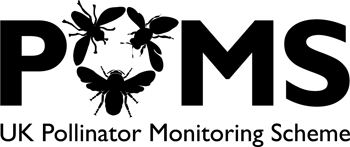
14 March 2018
_Andrena-haemorrhoa.jpg)
Solitary bee Andrena haemorrhoa visiting orchard flowers - photo by Nadine Mitschunas
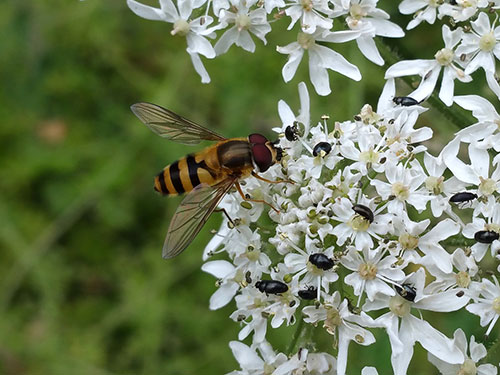
Hoverfly Epistrophe grossulariae and pollen beetles Meligethes sp. on Hogweed flowers - photo by Martin Harvey
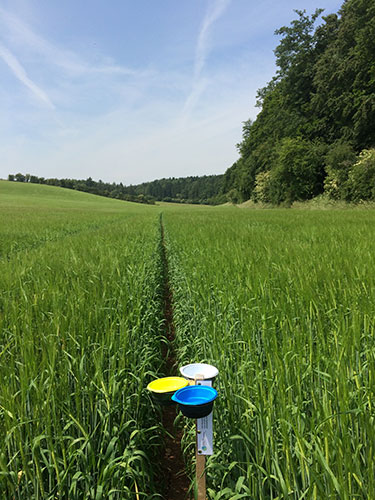
Pan-traps in a crop field - photo by Claire Carvell
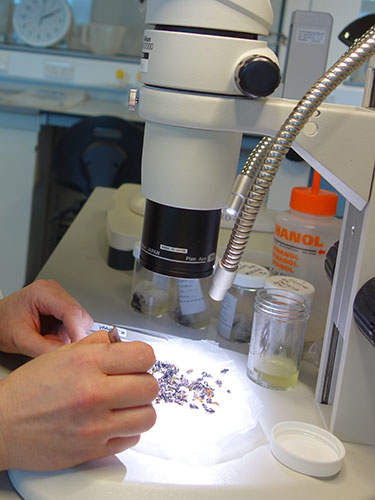
Specimens from pan-trap samples being sorted in the CEH lab
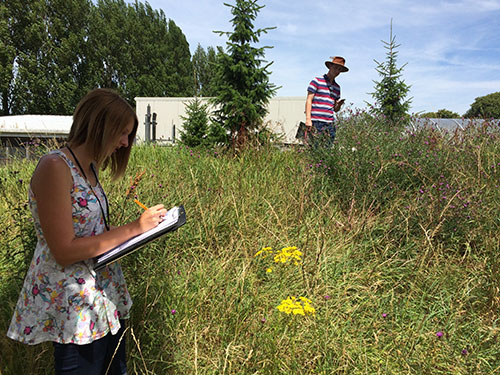
Carrying out a FIT Count - photo by Claire Carvell
With the help of many volunteers, this project aims to collect robust data on the distribution and numbers of pollinating insects, to help inform research into the conservation of this vitally important group of species.
One part of PoMS is an intensive sampling survey across 75 1km-squares in England, Scotland and Wales, and this is the part of the project for which we are seeking help.
The other part of PoMS is a public participation “FIT Count”, see below for more details.
One-km square survey
For this survey we are seeking volunteers to ‘adopt’ their nearest 1km square, either individually or as a small team of people. The network of squares can be seen at: https://www.ceh.ac.uk/sites/default/files/UK%20Pollinator%20Monitoring%20Scheme_posterv2.pdf.
In particular we are seeking volunteers for three squares in your area: for West Sussex: one square near West Itchenor and another near Southwater; for East Sussex one square near Brighton.
We’d be very grateful if you could spread the word among your networks to see if anyone is interested in taking on one of these squares. For anyone volunteering we will set up a meeting with a CEH member of staff at the chosen 1km square location for the first survey visit (due in late April 2018). We’d then ask volunteers to visit the square on 3 further occasions during summer to set out and take in water-filled pan traps. These need to be set out between 9 and 10am, and then collected in 6 hours later, with the insect specimens being returned to CEH (where the bees and hoverflies will be identified to species level, and other insects analysed at species group level).
Volunteers are also asked to identify flowering plants (to species level where possible) for some measures of flower abundance in the immediate vicinity of the traps, and to carry out some FIT Counts (see below) during the middle part of the day (but there is typically some ‘down time’ in the middle part of the day).
All the kit, maps and recording forms would be supplied by the project, and access permissions are already in place. Species records will subsequently be shared via NBN, subject to agreement with landowners.
The four sampling days are potentially quite hard work in open countryside! Volunteers will be contributing to a national scientific project that is providing good-quality evidence for changes in pollinator populations. See also the video guide at: https://www.youtube.com/watch?v=FZo8sZcZfvM
Read on for details of the FIT Count (which is a simpler survey that can be done by anyone at any location with flowers) - please pass on those details as well, but anything you can do to put us in touch with potential volunteers for the 1km surveys will be especially appreciated.
Flower-Insect Timed Count (FIT Count)
Can you help us count pollinators? Take part in the FIT Count by counting insects visiting a target flower patch over a 10-minute period. Anyone can take part in the FIT Count, at any location where there are flowers and insects, so please do spread the word! Full details and downloads of guides for the FIT Count are available here: https://www.ceh.ac.uk/pollinator-monitoring#takepart
See also the video guide at: https://www.youtube.com/watch?v=IuTiPEJI8rQ&t=12s
Martin Harvey
on behalf of the PoMS team
CEH and project partners
6 March 2018
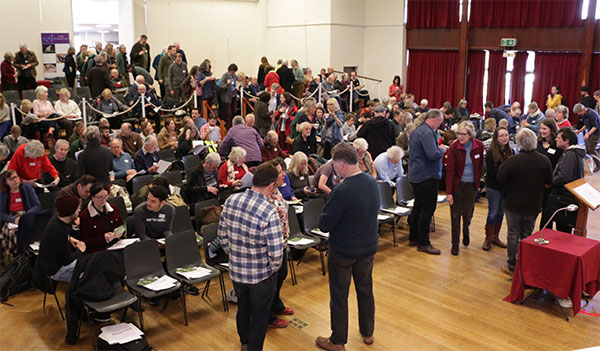
An opportunity to have a chat with speakers and attendees; coffee break at the 2018 Seminar.
The 29th annual Sussex Biological Recorders’ Seminar (née Adastra) was held at Oathall College in Lindfield on 17 February. It was the second year that The Seminar has been held there and, with the benefit of the lessons learned from last year’s event all seemed to go pretty smoothly (helped in no small part by the considerably more clement weather than we experienced the previous year). After registration and refreshments the 260 attendees were treated to the usual complement of absorbingly informative and entertainingly delivered talks on a broad range of subjects.
First on the agenda was Clare Blencowe (SxBRC Manager) who gave the audience an update on the SxBRC’s achievements over the past year as well a look ahead to the exciting plans the Record Centre has for the coming year. Clare was followed by Dr Erica McAlister, Senior Curator for Diptera, Natural History Museum, whose talk, “The Secret Life of Flies” was both fascinating and definitely not for the squeamish. Slides of tropical wingless marine flies and flesh-boring botfly larvae were shown as we were led from the extraordinary to the revolting. Her talk also highlighted some unusual recording opportunities for highly under-recorded species such as the Bat Fly, a wingless parasite of bats for which very few records exist.
The coffee break was followed by Graeme Lyons with a whistle-stop tour of the Sussex Wildlife Trust reserves and the more than 10,000 species that have been recorded on them. The recording of the 10,000th species was marked by a presentation to young naturalist James McCulloch who recorded Phytomyza ranunculivora at Graffham Common.
The Recorders’ Seminar is, we like to think, one of the highlights of the recording calendar but this year its position was underlined by the Sussex Botanical Recording Society choosing it to be the official launch of their magnum opus “The Flora of Sussex”, a stunning volume and absolute must have for any Sussex dweller with even the vaguest interest in natural history. The book’s creation, from the first glint in Paul Harmes’s eye to its arrival from the publishers was outlined in very amusing detail by Nick Sturt.
Lunch... mmm lunch ...was followed by Sarah Ward giving us an insight into the fantastic work she and her colleagues and volunteers do with both the SeaSearch and ShoreSearch projects, helping to conserve marine habitats and species. Next up was Penny Green, the ecologist at the Knepp Castle Estate who explained the ecological principles underlying the Knepp rewilding project and the original motivations for embarking on it in the first place.
The last two talks of the day both struck a more serious note, firstly Neil Hulme from Butterfly Conservation talking about the “Fritillaries for the Future” project and the efforts that are being gone to to save the regionally threatened Pearl-bordered and Small Pearl-bordered Fritillaries. Neil was followed by Ken Smith whose talk, “Latest on Sussex Lessers” detailed the precarious status of the Lesser Spotted Woodpecker and the efforts that are being made (through the use of highly ingenious monitoring equipment) to monitor its breeding success in the county. Despite both these talks being all about species that are under serious threat they were both highly positive in their outlook and showed what can be achieved when concerted action is taken.
The whole day was excellently MC’d by Paul Harmes in his usual inimitable style and it would appear everyone went home happy.
20 December 2017
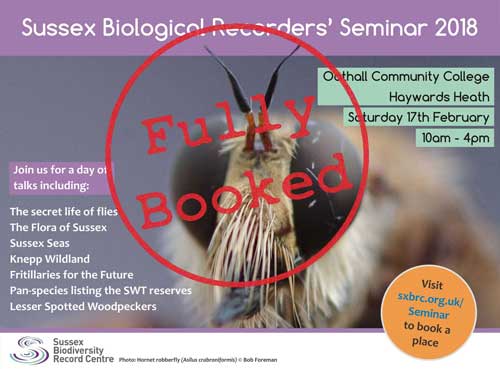
The Sussex Biological Recorders’ Seminar on Saturday 17 February is now open for bookings, and you’re invited!
If you’ve ever thought about getting more involved in recording wildlife in Sussex - there is no greater introduction than coming along to the seminar-formerly-known-as-‘Adastra’.
15 November 2017

From left to right: Roger Dumbrell, Zdenek Boucek and Peter Hodge, Wilmington Downs, 1 August 1971
Peter Hodge has been keeping field notebooks for Coleoptera in Sussex since 1971. At Sussex Biodiversity Record Centre we are occasionally given old field notebooks by recorders so we can extract the information and turn it into biodiversity records which go into our species record database, and in 2006 Sussex Biodiversity Record Centre began the task of digitising Peter’s notebooks.
Each notebook contains about 3,000 records, collected by Peter for surveys he carried out as well as casual records. For tasks such as these, volunteer power is vital seeing them through. Over the years many volunteers at SxBRC have been busy typing away over one of the fourteen notebooks, and by 2015 eight notebooks had been typed up, checked by Peter and uploaded into the Sussex database.
As well as Peter, another 1,000 people have recorded at least one beetle in Sussex with records going back as far as 1850(?)! Most of our data now comes to us in a digital format, making it much easier to get into our database quickly, but notebooks such as Peter’s are valuable sources of ‘historic’ data that can show us what’s changed over the last 40 years.
We were eager to get the rest of the notebooks completed so we could put together a comprehensive list of all the beetles recorded in Sussex and be able to share the data with national recording schemes, so in 2015 SxBRC applied for a Natural England Open Licensing of Species Data grant. This was a great opportunity to complete digitising Peter’s notebooks, as well as being an opportunity to look into how ‘Open Data’ works within biological recording and what challenges might face us in the future, including discussing with other Sussex Coleoptera recorders about making their data open and available on the internet. The final outcome would be an ‘as-complete-as-possible’, good quality Sussex Coleoptera dataset available for use under an Open Licence (CC-BY), minimising duplication of records and following recorders wishes with regards to sharing their data.
The project was carried out over 6 months, where staff and volunteers typed up the remaining 15,000 records as well as prioritising other beetle datasets for import. Gathering all the data together was just one part of the project, as we launched a consultation into data sharing with the Sussex beetle recording community. We also opened up dialogues with the 17 different national Coleoptera recording schemes in Great Britain to talk about how we could share data in the best way for them in the future - not just as a one off data exchange.
After being digitised, verified, filtered for any data not to be shared, and formatted - we had 92,465 records ready to go onto the NBN Atlas!
The NBN, or National Biodiversity Network, is a membership organisation that encourages sharing of biological data in the United Kingdom and makes it available through an online map - the NBN Atlas. The new Atlas was launched in April this year and currently holds data from 119 data partners, for 71,327 different species. From here you can download species data as well as look at it online and carry out analysis using the in-built atlas tools. This means that anyone who has discovered a beetle in Sussex and wants to check where else it’s been recorded can go onto the Atlas and search through our dataset, to see if it’s been recorded in Sussex before and where.
You can find the dataset on the NBN Atlas here: registry.nbnatlas.org
The project is finished, but we’re going to continue adding to the dataset and working with recording schemes as part of our ongoing commitment to sharing Sussex Coleoptera. If you download the data and do anything with it, we’d love to hear about it!
8 November 2016
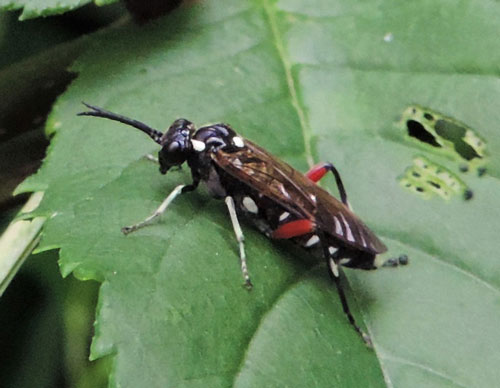
Privet Sawfly (Macrophya punctumalbum)
In the hedge a couple of metres from our back door in Sedlescombe, East Sussex (TQ782188) I have recently seen several examples of the rather handsome Privet Sawfly (Macrophya punctumalbum) wandering about on the leaves. I have not come across this here or anywhere else and have been unable to find any previous records from Sussex.
There is a thin spread of records across the southern part of Britain and it is widespread in Surrey, so it is probably simply under-recorded in Sussex, though I am surprised I have not seen it in our hedge before as I usually walk past it several times a day. It may have cycles of relative abundance and scarcity.
The larvae feed on ash, privet (Ligustrum vulgare), lilac and other members of the Oleaceae family and, rather unusually for insects of this kind, the adults browse on leaves of the same plants. There is a characteristic grazed patch towards the top right of the picture above. The picture is of a female and while males are found occasionally, the species is said to be mainly parthenogenetic.
This record, which may be a first for Sussex, shows the value of walking round the house several times a day and looking out for anything interesting. It helps one to see things that would otherwise have been missed as in the wider countryside the eye is drawn on to more interesting looking sites. It also provides a little exercise for the relatively housebound. The piece of hedge where these sawflies occur does not look a particularly promising spot though wild privet and ash grow together there.
Patrick Roper 7th June 2016
7 August 2015
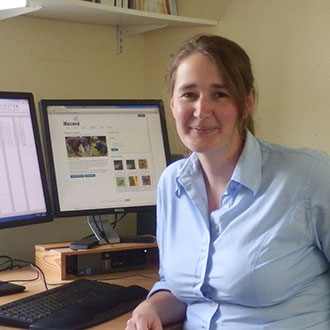
Clare Blencowe (Recordcentrus managerii)
“Hello! I’m Clare Blencowe - your new Record Centre Manager.” It’s something I’d meant to say sooner and now I find myself already a month into the job. Wondering, how did this happen?!
I’ve been an admirer of the Sussex Biodiversity Record Centre for the best part of a decade, since I was one of Penny Green’s volunteers. I’ve valued the support of the team here, in the intervening years, in my voluntary role as the Sussex coordinator for Butterfly Conservation’s BNM recording scheme.
Returning as the Record Centre Manager feels like an enormous privilege; I’m conscious that being the custodian of Sussex’s biodiversity information is also a great responsibility.
I’m lucky that there is already an excellent data request service in place, providing professional bespoke reports for anyone wanting biodiversity information for sites in Sussex.
I’m also inheriting good working relationships with a growing list of partners, including local planning authorities, government agencies, conservation bodies and other organisations to whom biodiversity information is important, such as water companies. Through these partner relationships we make high quality environmental information available to decision-makers in planning, land management and conservation across Sussex.
These are services we can only provide by working closely with the local recording community: the people who are actually out there, in Sussex, identifying the great variety of species and habitats that exist and feeding that information through to us. The effort that goes into this - driven largely by volunteers, enthusiasts and folk who’ve simply made the time to notice and appreciate what’s around us - is hugely inspiring. And the results, from microscopic observations to landscape-scale surveys, as showcased at our annual Adastra seminar, are endlessly fascinating.
We couldn’t handle all this information without technology: systems and databases enable us to organise, analyse and interpret all this data, as well as present it in accessible and interesting ways. I’ve arrived at a time when technology, especially online recording, is revolutionising biological recording, and is bringing with it a new set of opportunities and challenges. This makes recording groups and the people involved in recording as critical as they’ve ever been, to ensure data users can continue to have confidence in the quality of the information we provide.
But these are not challenges we’re facing on our own. Here at Sussex Biodiversity Record Centre, we’re also part of the Association of Local Environmental Record Centres, and the National Biodiversity Network (known as the NBN). We will all need to work together to ensure biological data continues to be collected, valued, looked after and shared appropriately.
As the saying goes: we live in ‘interesting times’. And I’m looking forward to getting stuck in.
30 April 2014
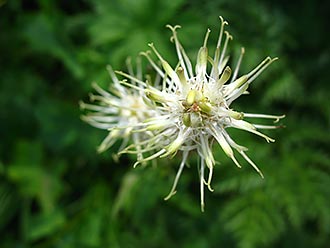
Spiked Rampion (Phyteuma spicatum)
© 2007 “Bossi” and made available under an Attribution-ShareAlike 2.0 Generic licence.
Spiked Rampion (Phyteuma spicatum) is one of the rarest plants in the UK, but it is thriving in some parts of East Sussex and there may be plants we don’t know about. If you think you may have seen a plant, please send a photo and location (preferably a grid reference) to Bob Foreman here at the record centre or call 01273 497570.
We have prepared a Spiked Rampion flyer to aid with identification in case you’re not sure what this plant looks like.
15 August 2013
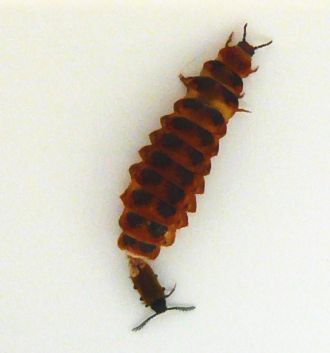
Copulating Drilus flavescens
Photo: Kate Frankland

Drilus flavescens female and two males
Photo: Peter Tinning
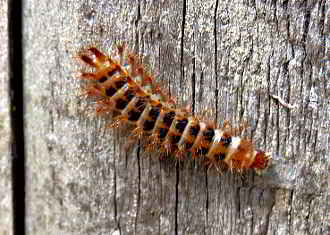
Drilus flavescens larva
Photo: Richard Roebuck
Over the past month or so we’ve had a few sightings of Drilus flavescens sent in accompanied by wonderful photos. It is a Nationally Scarce beetle species which can be found in woodland and grassland on and around the chalk downs of South East England, and has a rather strange life history.
The male is your average-looking winged beetle, just a few millimetres long with prominent combed antennae which are thought to pick up the appealing pheromones of the female. When a male follows the scent-trail, however, and finds the female, he’s in for a shock. The female is a wingless, grub-like monster weighing in about four times as big as him. When a female beetle looks like this it is called a ‘larviforme female’ and you will recognise the more familiar example of this in the form of a Glow-worm female which is also like a caterpillar. The male Glow-worm is a small black winged beetle and is attracted to the glow of the female’s curled abdomen.
Like the Glow-worm larva, the larva of this species takes at least two years to mature, invading and eating about 3 or 4 snails a year, targeting progressively larger snails to sate its appetite. It moults and over-winters in an empty snail shell from about mid-September. The larvae look pretty spectacular covered in orange bristles, and their poisonous bite kills their snail prey which they then dissolve into a soup using their digestive enzymes.
Pupation and adult emergence happens around May time and adults are then recorded up until late July, or this year into August. We have about 55 records of this species in Sussex, with only 16 of these records since the year 2000. If you have spotted this species we’d be grateful if you could send in a photo to Bob Foreman with details of where and when you saw it.
31 May 2013
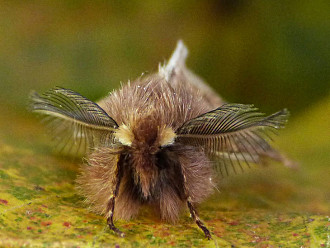
Plumed Prominent (Ptilophora plumigera)
The Plumed Prominent moth has evaded capture for 14 years in Sussex, although the habitat that it requires hasn’t apparently changed in that time, we were starting to get worried that we hadn’t encountered it. Well known for its disappearing acts, this species skulks around Field Maples (on which its larvae feed) on the chalk downs in the south of England, and in Sussex it prefers the scarp slope woodlands of West Sussex. So we knew where to concentrate our efforts; all we needed was a bit of patience and some warm clothes.
In 2011 a small group of us tried several times at two of the most likely locations but all we got were Bricks and Red-green Carpets. Luckily if Plumed Prominents haven’t turned up by 9:00pm you know you can head home. The male Plumed Prominent flies early on in the evening and then the female comes out much later on in the evening, but we figured if the males weren’t on the wing it was unlikely that the females would be. Despite carrying traps and generators up and down steep hills and dogged perseverance we didn’t manage to catch up with this species in 2011.
Deterred? Oh no, this just makes it more of a challenge, it’s all part of the chase. So on 8 November we headed to the hills to look for the Plumed Prominent again, or the ‘Bonfire Night Moth’ as it is so called due to its emergence around this time of year. We set the traps up in the usual places, and after 20 minutes we decided to go to the bottom of the hill and check the trap there, we bumbled around there as there was a distinct lack of moths and we started looking at snails, harvestmen and plants - we are easily distracted. We then walked back up the hill to check the other traps and, as we neared the first trap we didn’t feel very hopeful, it was just part of our regular routine. Hang on - what’s this by the trap? Yes! Our first ever Plumed Prominent, and what a looker; adorned by a furry cape and huge feathery antennae he was everything we had hoped for. There were another three males in and around our traps so we were very pleased.
These were the first Plumed Prominents encountered in Sussex for 14 years and it has been great to confirm its continued residency in the county. This success highlights the importance of persistent and targeted survey work for species that haven’t been recorded for some time. Some species are scarce and some species are under-recorded as to see them one has to go out at unsociable hours and stand around in inclement weather. The Plumed Prominent is a rare, under-recorded and enigmatic species; a species that I would like to see again.
29 October 2012
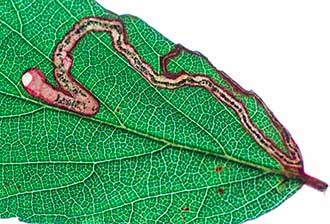
Stigmella aurella mine in the leaf
Photo: Tony Davis/Butterfly Conservation
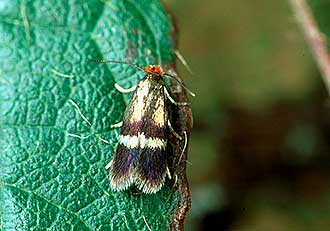
Stigmella aurella adult moth
Photo: Ian Kimber/UKMoths
When the leaves are just on the turn in the autumn, we think it’s the best time to be in the woods - not only to enjoy the beautiful colours, but also to be looking for some of our more under-recorded native fauna. Have you ever noticed leaves on trees, such as oaks and hazel, that have been carefully rolled over, or that have curious blotches or silver wiggly lines on them? These are signs of fascinating lives going on within these leaves - whether it is in a woodland or in your garden there are leafminers at work.
Leafminers represent a cross-section of specialists from several species groups such as moths, flies and wasps. We’re on the lookout for micro-moth leafminers so we will tell you a bit about these. Most species of leafminers have one or two species of plant or tree that they will feed on. The adult micro-moth will lay its tiny egg on the leaf of its food plant and when the larva hatches from its egg it burrows in to the leaf. It will then spend some or all of its larval phase between the epidermal or outer layers of the leaf, feeding in safety away from predators’ eyes.
The mines themselves vary in shape and size and this, along with knowing what the food plant is, enables us to identify a majority of the leaf mines made by micro-moths, although some need to have the adult reared to confirm which species has been growing inside when it finally hatches out. There are a few different types of mine including blotch, gallery and blister - some are lined with silk, some create folds in the leaves and some have small windows that have been created by feeding larvae - they all have their own distinguishing features which, with the aid of a key, can point towards which species it is.
If you hold the leaf up to the light you can often see the inhabitant busily eating away at the juicy green tissue within. As the larva feeds it usually leaves a trail behind it, which gets wider as they get fatter. When the larva has filled its boots, it will emerge through an exit hole and pupate, sometimes dropping to the ground and pupating in the soil. Some of the later stages of the larvae come out of the leaf and carry on feeding in the safety of a self-constructed funnel-like shelter that they roll in the leaf until they are ready to pupate.
Further reading: www.leafmines.co.uk - your guide to British and European leafmines
4 May 2012
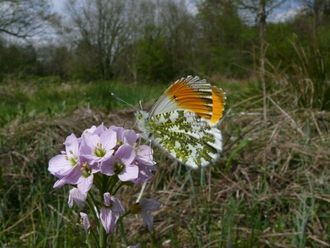
The Orange-tip, one of our earliest non-overwintering butterflies and a sure sign Spring has arrived.
Photo: Paul Marten/Sussex Wildlife Trust.
One of the first signs of spring is glimpsing the unmistakable bright orange flashes of the male Orange-tip Anthocharis cardamines as it patrols along country lane verges and hedgerows looking for a female. Emerging in April they are one of our earliest non-overwintering butterflies to see, and a sure sign that blissful sunny spring days are here and butterfly recording can start in earnest.
The male butterfly is easy to spot when it is on the wing, with its vibrant orange wing tips; a wonderful sight for us but this bright colouration is thought to be a warning sign to repel predators. This bold butterfly wouldn’t make a very tasty snack due to the mustard oils which will have built up in the body when it was a caterpillar feasting on its foodplants, such as Garlic Mustard Alliaria petiolata and Cuckooflower Cardamine pratensis.
We’re looking to collect as many Orange-tip records as we can in order to fill the map of Sussex for the forthcoming Butterfly Conservation Sussex Butterfly Atlas and we’d like you to send in your records.
Drop us a line when you spot a male Orange-tip, whether it’s in your garden or in the countryside we’ll be grateful to hear from you. We’ll need your name, the date you saw it, and where you saw it, preferably an OS grid reference, and a road name and town - the more detail the better.
Please send your Orange-tip records to Bob Foreman or 01273 497570.